
About UsThe Numismatic Bibliomania Society is a non-profit association devoted to the study and enjoyment of numismatic literature. For more information please see our web site at coinbooks.org SubscriptionsThose wishing to become new E-Sylum subscribers (or wishing to Unsubscribe) can go to the following web page link MembershipThere is a membership application available on the web site Membership Application To join, print the application and return it with your check to the address printed on the application. Print/Digital membership is $40 to addresses in the U.S., and $60 elsewhere. A digital-only membership is available for $25. For those without web access, write to: Charles Heck, Treasurer
AsylumFor Asylum mailing address changes and other membership questions, contact Terry at this email address: terrywhite5475@yahoo.com SubmissionsTo submit items for publication in The E-Sylum, write to the Editor at this address: whomren@gmail.com BUY THE BOOK BEFORE THE COINSale Calendar |
- WAYNE'S WORDS: THE E-SYLUM JUNE 23, 2019
- KOLBE & FANNING SALE 153 ANNOUNCED
- KOLBE & FANNING BUY OR BID SALE NUMBER 10
- NEW BOOK: DIGITAL CASH
- BOOK REVIEW: CHICAGO COIN CLUB MEDALS AND TOKENS
- F+W MEDIA ASSET SALES APPROVED
- MISSOURI PAPER MONEY RESEARCH FILES ON NNP
- THANKS FROM RICH KELLY AND NANCY OLIVER
- TRADER JON'S TRADERNOMICS
- NOTES FROM E-SYLUM READERS: JUNE 23, 2019
- NEW COIN SHOP IN ADELAIDE
- ON MEDALISTS AND MEDALLISTS
- VOCABULARY TERM: NUMBERING SYSTEM
- THE MICHIGAN COIN COMPANY
- THE GREAT PRECIOUS METALS BOOM AND BUST
- THE TREASURE OF AMERSFOORT
- COIN BOARD TYPE SET EXHIBIT
- TIRUCHIRAPPALLI INDIA COIN SHOW
- JUNE 2019 HONG KONG FAIR EDUCATIONAL SYMPOSIUM
- JUDAEAN COINS FROM THE MOUSSAIEFF COLLECTION
- MORTON & EDEN JUNE 2019 SALE SELECTIONS
- FOURTH CENTURY BRONZE COINS FOUND IN PARION
- CARAUSIUS DENARIUS FOUND 30 YEARS AGO OFFERED
- THE AUSTRALIAN KANGAROO ONE TON GOLD COIN
- WHICH TUBMAN PORTRAIT TO USE?
- MORE ON THE AUSTRALIAN BANKNOTE DESIGN TYPO
- ARTIST CREATES BREXIT BANKNOTE
- MR. 880, AMERICA'S WORST COUNTERFEITER
- FACEBOOK'S LIBRA CRYPTOCURRENCY
- LOOSE CHANGE: JUNE 23, 2019
- PENNY PYRAMID HOPES TO BREAK GUINNESS RECORD
Click here to access the complete archive
To comment or submit articles, reply to whomren@gmail.com
Content presented in The E-Sylum is not necessarily researched or independently fact-checked, and views expressed do not necessarily represent those of the Numismatic Bibliomania Society.
WAYNE'S WORDS: THE E-SYLUM JUNE 23, 2019
 This week we open with two new sales from numismatic booksellers Kolbe & Fanning, one new book, one review,
a Newman Numismatic Portal update and a note from numismatic researchers Rich Kelly and Nancy Oliver.
This week we open with two new sales from numismatic booksellers Kolbe & Fanning, one new book, one review,
a Newman Numismatic Portal update and a note from numismatic researchers Rich Kelly and Nancy Oliver.
Other topics this week include Missouri paper money, the great precious metals boom and bust, coin shops, coin shows, coin boards, coin hoards, coin finds, coin photos, Judean coins, one-ton gold coins, typos, cryptos and America's worst counterfeiter.
To learn more about "Mr. 880", digital cash, the Chicago Coin Club, Krause Publications parent F+W Media sales, apothecary weights, Tradernomics, the Purple Penny, the unique 1870-S Half Dime, the Brexit banknote, "Wahsington" D.C., and alarmingly precise dummy of a person, read on. Have a great week, everyone!
Wayne Homren
Editor, The E-Sylum
KOLBE & FANNING SALE 153 ANNOUNCED
Kolbe & Fanning's next numismatic literature sale will close July 13, 2019. Here's the announcement. Some great items here! The subscription Crosby and large paper Hickcox have eluded me while building my own library. -Editor
 Kolbe & Fanning Numismatic Booksellers are announcing our Sale 153, which will be held on
Saturday, July 13, 2019. The 500-lot sale includes a fine selection of books on ancient, world and U.S. numismatics, with especially important
offerings from the library of Philip J. Carrigan.
Kolbe & Fanning Numismatic Booksellers are announcing our Sale 153, which will be held on
Saturday, July 13, 2019. The 500-lot sale includes a fine selection of books on ancient, world and U.S. numismatics, with especially important
offerings from the library of Philip J. Carrigan.
The sale features particularly notable runs of American auction catalogues, along with core references on ancient and world coins, many of them in fine bindings.
Some highlights of the sale include:


Lots 8 and 48
Lot 8: an attractively bound copy of the groundbreaking 1755 auction catalogue of the Richard Mead collection, the first truly notable British coin sale
lot 48: the massive plate volume of Ernst Justus Haeberlin's extraordinary 1910 Aes Grave

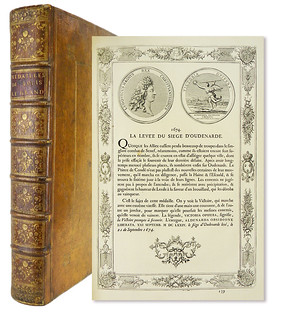
Lots 106 and 112
Lot 106: a beautiful 1824-1826 quarto edition of Visconti's exquisitely illustrated Iconographie grecque
Lot 112: the rare expanded second edition (1723) of the magnificent compendium of Louis XIV medals, Médailles sur les principaux événements du règne entier de Louis le Grand

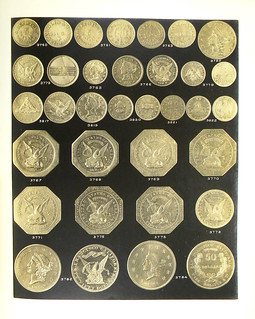
Lots 232 and 325
Lot 232: a remarkable archive of materials relating to the establishment and early operation of ANACS, from the Eric P. Newman files
Lot 325: Newman's plated copy of the 1912 Henry Chapman catalogue of the George H. Earle collection


Lots 349 and 359
Lot 349: an original subscription set of Crosby's Early Coins of America, as published in printed paper covers
Lot 359: a very large collection of 176 different Thomas Elder catalogues, part of the offerings in this sale of American auction catalogues collected by Phil Carrigan, which include the extensive series issued by Cogan, Mehl, Stack's, Woodward, the Chapmans, Frossard, Low, Haseltine, Bolender, et al.
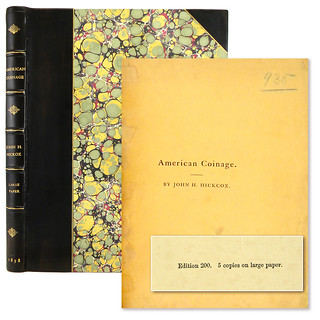

Lots 393 and 462
Lot 393: the finest known copy of the large-paper edition of John H. Hickcox's 1858 An Historical Account of American Coinage, one of only five copies printed
Lot 462: an almost entirely complete set of Hans M.F. Schulman catalogues, forming an exceptional resource on world coinage.
Bids may be placed via post, email, fax or phone, as well as online. Kolbe & Fanning use Auction Mobility as our third-party online bidding platform. Auction Mobility is an app-based platform allowing users the ability to participate in the sale through phones, tablets and computers. To register for the sale, bidders must go to bid.numislit.com and sign up. Once you have set up an account, you may browse lots, place advance bids, or participate in the live sale online. Those wishing to participate on their devices can download the Kolbe & Fanning app through the Apple or Google Play Store.
The printed catalogue of Sale 153 was mailed to active customers this week. A PDF of the printed catalogue has been posted to our main website at numislit.com for those who prefer that format. Bids placed via post, email, fax or phone must be received by July 12, the day before the sale, in order for them to be processed. Advance absentee bids may also be placed at any time online at bid.numislit.com; live internet bidding will be available during the sale itself through the same platform.
Kolbe & Fanning Numismatic Booksellers LLC is a licensed and bonded auction firm in the State of Ohio. For more information, please see the Kolbe & Fanning website at numislit.com or email David Fanning at df@numislit.com. To register for the sale, go to bid.numislit.com . We look forward to your participation.
KOLBE & FANNING BUY OR BID SALE NUMBER 10
Numismatic Booksellers Kolbe & Fanning also submitted this announcement of their tenth "Buy or Bid Sale" which closes on July 5, 2019. Good luck, everyone! -Editor
 Kolbe & Fanning Numismatic Booksellers have announced our tenth “Buy or Bid Sale,” which begins now and
will close on July 5, 2019. The sale focuses on modestly priced books, giving collectors an opportunity to add to their libraries at minimal
cost.
Kolbe & Fanning Numismatic Booksellers have announced our tenth “Buy or Bid Sale,” which begins now and
will close on July 5, 2019. The sale focuses on modestly priced books, giving collectors an opportunity to add to their libraries at minimal
cost.
There is no printed catalogue. The PDF catalogue is available now for downloading from the Kolbe & Fanning website at numislit.com.
As the name of the sale suggests, customers may bid on items they wish to acquire or buy them outright at the published price. The Terms of Sale will give full instructions on how to participate: please read it carefully.
The sale includes over 1200 works on ancient, medieval and modern coins, as well as general works, periodicals and sale catalogues. “Buy” prices have been kept low to promote sales. To further encourage participation, the firm is offering free domestic shipping to bidders spending at least $300; there is also no packing and processing fee for this sale. Again, please read the Terms of Sale before participating.
Please send all bids to orders@numislit.com or use the bid sheet included at the end of the PDF catalogue.
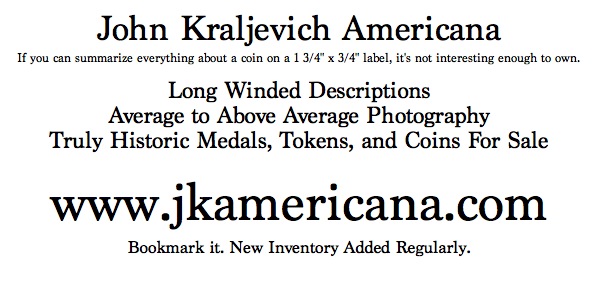
NEW BOOK: DIGITAL CASH
The Newman Numismatic Portal isn't only a resource for numismatists and collectors - it's a trove of data waiting to be discovered and used by researchers and writers of all stripes, including historians, art historians, and economists. A new book on the history of digital cash draws upon NNP and its partner Internet Archive. Here's an IA blog post by the author. A book launch event will be held Tuesday, June 25th at the Internet Archive headquarters in San Francisco. -Editor
DIGITAL CASH: The Unknown History of the Anarchists, Utopians, and Technologists Who Created Cryptocurrency
by Finn Brunton.
 The history of money is history itself. From the accounting and contracts of Sumerian cuneiform tablets (the
earliest written language) to buried coin hoards, stamps and letters of credit, Incan khipu knot-counts, or the maps and censuses written in the
service of levying taxes, part of the great archive from which history is made are the records of cash, debt, credit, assets, and coinage.
The history of money is history itself. From the accounting and contracts of Sumerian cuneiform tablets (the
earliest written language) to buried coin hoards, stamps and letters of credit, Incan khipu knot-counts, or the maps and censuses written in the
service of levying taxes, part of the great archive from which history is made are the records of cash, debt, credit, assets, and coinage.
A lot of that archive is durable: cowry shells, wooden tally-sticks, clay tablets, coins buried under floorboards or in the hulls of sunken ships. (/Rai/ stones, the indigenous currency of the Micronesian island of Yap, will outlast us all.) And a lot of that archive gives people their own incentives to preserve and maintain: saving precious metals, stock certificates, banknotes, deeds, or the proofs of kinship debts and IOUs. But most of the money transacted now is electronic. How could you write the history of digital cash?
That's where the Internet Archive comes in. About eight years ago I began work in earnest on a book about the prehistory of cryptocurrency: the technologies, visions, subcultures, and fantasies that drove the project of building digital objects that could work like cash — anonymous transactions with money that could prove itself, as a dollar does, rather than needing the identities of the transactors, like a credit card.
Digging up this history meant a crash course in the history of money itself — and, as strange as this might sound, the /history/ of the history of money, how people thought about what money meant and how to read it at different times, with collections like the Newman Numismatic Portal and documents like the playwright and poet Joseph Addison's marvelous 1726 “Dialogues Upon the Usefulness of Ancient Medals,” a kind of dreamy, melancholy short story about coins, poetry, and the legacies of the past.
It also meant leaning about various utopian projects which used new forms of money and economic schemes to try to change society — these were often led the sort of ahead-of-their-time, or out-of-this-world, characters whose archives are, to put it gently, difficult to find. Not for the Internet Archive, though: the documents of the strange project of American Technocracy in the 1930s — like an autobiography written from the perspective of the economic price system! — are, through phone, tablet, or mouse, at one's fingertips.
The book, focused as it is on small circles of monetary and cryptographic utopians in the Bay Area of California from the 1970s through the arrival of Bitcoin, also required study of the subcultures, publications, and movements within which my subjects crossed paths and dreamed big dreams — venues like Mondo 2000 (individual issues are incredibly rich time capsules and the people around Ted Nelson's amazing Xanadu. But, of course, many of these people were among the first to leave print behind and begin writing and publishing primarily online — especially on the fragile, ephemeral Web. Which is where the Wayback Machine came in! Here crucial developments that would otherwise be lost were preserved, like Hal Finney's “reusable proof of work” token system — an important step toward what would become Bitcoin and subsequent cryptocurrency and blockchain systems.
About the Author: Finn Brunton (finnb.net) is the author of Spam: A Shadow History of the Internet (2013) and Digital Cash: The Unknown History of the Anarchists, Technologists, and Utopians Who Created Cryptocurrency (2019), and the co-author of Obfuscation: A User's Guide for Privacy and Protest (2015) and Communication (2019). He teaches in Media, Culture, and Communication at New York University.
To read the complete article, see:
Money and Utopia at the Internet Archive
(http://blog.archive.org/2019/06/11/money-and-utopia-at-the-internet-archive/)
BOOK REVIEW: CHICAGO COIN CLUB MEDALS AND TOKENS
Dennis Tucker submitted this review of Bill Burd's book on the medals and tokens of the Chicago Coin Club. Thanks! -Editor
Collecting 100 Years of Medals and Tokens of the Famous Chicago Coin Club
Book review by Dennis Tucker
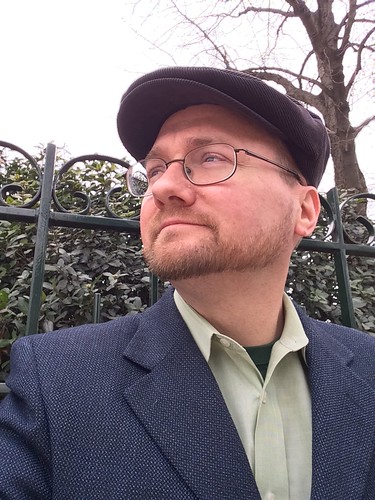 One of my greatest numismatic
regrets is that I lived in the city of Rochester, New York, for nearly twelve years, and in all that time I never joined the venerable and storied
Rochester Numismatic Association.
One of my greatest numismatic
regrets is that I lived in the city of Rochester, New York, for nearly twelve years, and in all that time I never joined the venerable and storied
Rochester Numismatic Association.
I've been a coin collector since I was about seven years old. The coin bug bit me hard, and I was hooked through middle school and high school. In college I kept up with the hobby, to a lesser degree but still actively. At the University of Rochester I subscribed to Coin World and Numismatic News, bought a little, sold a little, read a lot. But I was fairly solitary in my hobby world, mostly collecting through mail order and learning from books and periodicals, rather than attending many coin shows and joining a local club.
Benefits of Coin Club Membership
Two benefits of every coin club are like-minded camaraderie and a venue to learn directly from longtime collectors. I lost out on that, and my loss
was compounded: the Rochester Numismatic Association isn't just any coin club. It's one of the oldest in the United States; it has a rich
history, counting famous collectors such as John Jay Pittman among its members; it has a decades-long program of issuing original medals. At the same
time, there was a lot I could have offered the club as a writer and artist, but most of my creative energy (outside of classes) I poured into the
campus humor magazine, student newspaper, and literary journals.
I don't regret the path I ended up taking as a numismatist, but I do look back and wonder what might have been, if I'd been more active in my local club.
When medal collector Timothy J. Corio published his book Rochester Numismatic Association Medals: A Pocket Guide in 2010, I bought a copy as a way of communing with my old city and making up for some of the lost time. (Every RNA president since 1913, including Pittman, has been honored by the club with a portrait medal, and they make an impressive collection. Corio describes them with text and nicely done photography.)
A few years later I was able to add another club-medals book to my library, this one hailing from the Windy City.
William Burd Chronicles the Chicago Coin Club
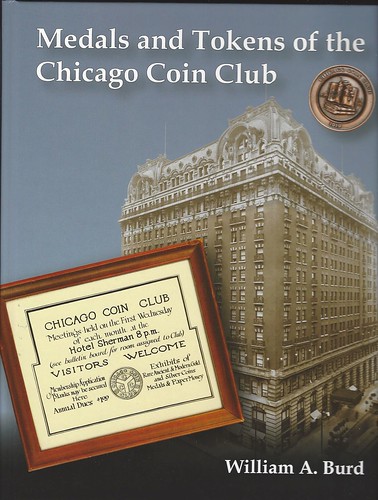 The Chicago Coin Club is another old and storied numismatic group, and now
it, like Rochester, has a book devoted to its club medals. Its title is Medals and Tokens of the Chicago Coin Club. Author William A. Burd, a
member of the club since 1993, is also a longtime professional dealer, as owner of the Chicago Coin Company, Inc.
The Chicago Coin Club is another old and storied numismatic group, and now
it, like Rochester, has a book devoted to its club medals. Its title is Medals and Tokens of the Chicago Coin Club. Author William A. Burd, a
member of the club since 1993, is also a longtime professional dealer, as owner of the Chicago Coin Company, Inc.
Medals and Tokens of the Chicago Coin Club was published in 2018, as the club was nearing its 2019 centennial. In the introduction Burd relates how he started his own collection of CCC commemoratives in 1994, with that year's 75th-anniversary medal. “While building this collection, I had difficulty finding background information regarding the various issues,” he recalls. “I began to assemble a simple catalog, adding information as I found it. I realized other collectors might benefit from my efforts and decided to put the material into book form.”
“Other collectors might benefit” indeed!
Burd's “simple catalog” grew into an impressive 108-page hardcover book, wonderfully illustrated and brimming with history—an “invaluable study,” as Carl Wolf says in the foreword, “the most significant work on the subject, a rich source of numismatic history.”
The author begins pre-1919, setting the context with items from the CCC's predecessor clubs—the Chicago Numismatic Society and Branch No. 1 of the American Numismatic Association. These early medals of 1907 to 1914 include some delightful and historic pieces, and some real rarities, with connections to millionaire collector Virgil Brand, the USS Nashville, early American aviation, the Art Institute of Chicago, and President William Howard Taft.
The Chicago Coin Club started in 1919, as a reorganization of ANA Branch No. 1. Its token and medal production started that year with an aluminum “one mill” or “one disme” that was handed out to members. That was followed by a 100th-meeting medal in 1927, a counterstamped Columbian Exposition silver half dollar in 1933, a 25th-anniversary medal in 1944, and various counterstamped Mexican pesos and other coins, meeting and anniversary medals, festival commemoratives, elongated coins, plaquettes, invitations, ceramic medallions, ornaments, encased postage, committee tokens, good-fors, and other collectibles issued from the early years to date.
Burd's approach to presenting these pieces, as he acknowledges in the introduction, is more that of a storyteller than a technical writer. Yes, he gives mintages, compositions, sizes, and issue prices, but he presents this data in narrative form—an approach that coin collectors who relish the history behind their treasures will find very engaging.
The photographs of the medals and tokens (by professional photographer Steve Wagner) are accompanied by images of related tickets, badges, steel dies, boxes, books, buttons, and other ephemera. This auxiliary art provides another layer of historical context.
In a separate chapter Burd describes American Numismatic Association conventions held in Chicago from 1891 to the present day. This chapter is also illustrated with booklets, autographed show programs, medals, convention ribbons and badges, wooden nickels, and other treasures.
Another chapter describes the Central States Numismatic Society conventions held in Chicago from 1939 to date. These assemblies developed their own history of medals, badges, and other collectibles. Many of the medals feature portraits of one of Illinois' most famous citizens, Abraham Lincoln, making them desirable among collectors of Lincolniana. (They're discussed in chapters 3 and 4 of Fred L. Reed's award-winning book Abraham Lincoln: The Image of His Greatness and in its sequel, Abraham Lincoln: Beyond the American Icon.)
An Abundance of Appendices
Burd expands his coverage of the Chicago Coin Club's medals with several appendices. One describes the club's award-medals program (1955 to date,
including medals for merit, past presidency, literary accomplishment, exhibiting, and speaking).
These appendices, like the rest of the book, are richly illustrated. They offer medallic art by Ulric H. Ellerhuson and other designers, and images of stamped leather, clamshell money, replica Yap stones, and other curiosities. Robert D. Leonard Jr., author of Curious Currency: The History of Money From the Stone Age to the Internet Age (among other studies of “primitive” money), is a longtime member of the Chicago Coin Club, and his influence is seen in the club's more than 20 souvenir cards accompanied by either replicas or authentic pieces of “odd and curious” money (bark cloth, African trade beads, kisi kilindi money, Civil War postage stamps, actual gold dust, cowrie shells, etc.). Appendix B catalogs these, plus obsolete-currency sheets, various scrip issues, and other club souvenirs. Other appendices describe and catalog club bulletins and periodicals, and medals and tokens produced by a spin-off organization, the Chicago Numismatic Roundtable, in the 1930s and beyond.
Any of these subjects could fill a book of their own, and it's wonderful to see them here, even if they're just summarized in appendix format.
Building or Expanding a Collection For hobbyists William Burd's book is a valuable roadmap to collecting Chicago's medals and tokens. It always helps to have an active collector lay the groundwork for you in a standard reference, especially in the field of privately minted commemoratives. Record-keeping is one thing on the federal level: the United States Mint keeps track of things with archivists, historians, an organized infrastructure, and institutional memory maintained by standard documentation and the full depth and breadth of government resources. A coin club has far fewer resources—club activities aren't always well-documented, records can be lost or destroyed over time, memories fade, and club members pass away. Documentation in books like Medals and Tokens of the Chicago Coin Club helps strengthen the hobby's collective memory. That's important whether you live in Chicago or not, whether you belong to this particular club or not.
Excitement Over Medals, and More Celebrations
Another significant aspect of William Burd's Medals and Tokens of the Chicago Coin Club is the sense of inspiration it evokes. Reading this
book should excite today's coin-club leaders. It's an impetus to create new medal programs that stand the test of time. What could be better than
medals and tokens to commemorate a coin club, honor its officers, recognize its members, and celebrate its milestones? There are many active and
experienced medallic artists working in the United States today, available for contract work, who can immortalize your club with beautiful sculptured
mementoes. Medals are material culture. They ensure that a coin club will be remembered, through numismatic study and collection, well into the
future.
“What stood out the most for me in preparing this book was the enthusiasm and energy over the years of club members in their efforts to produce the best medal, the best token, and the best convention,” Burd writes. “This enthusiasm began with the Chicago Numismatic Society over a hundred years ago and continues today.”
Thousands of hobbyists will celebrate the Chicago Coin Club at the American Numismatic Association World's Fair of Money in August this year. The convention is being held in Rosemont, just outside Chicago, and the club will have an exhibit of its medals and tokens on display based on William Burd's research. Soak it all in, and start or expand your own collection! And if you collect rare numismatic literature, be sure to add to your library a copy of the Chicago Coin Club special edition of the 73rd-edition Red Book, from a small limited print run of 250 copies.
A great review of a great book. Token and medal collectors and any student of U.S. numismatic history should own a copy. See the earlier articles linked below for ordering information. -Editor
To read the earlier E-Sylum articles, see:
NEW BOOK: CHICAGO COIN CLUB MEDALS AND TOKENS
(https://www.coinbooks.org/v21/esylum_v21n10a04.html)
BOOK REVIEW: CHICAGO COIN CLUB MEDALS AND TOKENS
(https://www.coinbooks.org/v21/club_nbs_esylum_v21n19.html#article5)
BOOK REVIEW: CHICAGO COIN CLUB MEDALS AND TOKENS
(https://www.coinbooks.org/v21/esylum_v21n20a07.html)
CHICAGO COIN CLUB CENTENNIAL RED BOOK
(https://www.coinbooks.org/v22/esylum_v22n22a04.html)
F+W MEDIA ASSET SALES APPROVED
A bankruptcy court has approved sales of book and periodical assets from Krause Publications parent F+W Media. Auctions were held on June 10 and 13, 2019. Gerry Tebben and others forwarded articles - here are some excerpts. Thanks. The first, from Folio, was published June 17. -Editor
 Special interest magazine publisher F+W Media is due back in Delaware bankruptcy court Monday afternoon, where the
company is expected to present the winning bidders emerging from an auction of its remaining media assets, the latest step in a process that began
when the company filed for Chapter 11 protection in March, citing over $100 million in debt.
Special interest magazine publisher F+W Media is due back in Delaware bankruptcy court Monday afternoon, where the
company is expected to present the winning bidders emerging from an auction of its remaining media assets, the latest step in a process that began
when the company filed for Chapter 11 protection in March, citing over $100 million in debt.
Unlike the company's books division—the entirety of which went to Penguin Random House for $5.6 million at a similar auction last week—the magazine side was broken up and auctioned off in pieces, with the largest chunks going to Active Interest Media subsidiary Cruz Bay Publishing and Macanta Investments, the investment vehicle for Terence O'Toole, who is co-managing partner of Tinicum Inc., the private investment firm that acquired a majority stake in F+W in 2014.
... Cruz Bay Publishing secured successful bids for ... F+W's collectibles group, which comprises six additional print magazines, for $350,000.
To read the complete article, see:
F+W Media Reveals Winning Bidders at Bankruptcy Auction
(https://www.foliomag.com/fw-media-announces-winning-bidders-bankruptcy-auction/)
F+W Media, the publisher of niche service titles that filed for Chapter 11 bankruptcy protection in March, this week told the court it raised $7.75 million by auctioning off its magazine titles.
A 16-hour auction involving 17 bidders resulted in breaking up F+W's media properties among six separate sales, a debtor attorney told the court.
F+W Media's past attempt to build an ecommerce business was cited by current company management as a major mistake. Its bankruptcy filing showed debt of $105.2 million and $2.5 million in available cash.
To read the complete article, see:
F+W Media's Bankruptcy
Auction Nets Almost $8M, Magazines Sold Off
(https://www.mediapost.com/publications/article/337177/fw-medias-bankruptcy-auction-nets-almost-8m-ma.html)
The F+W Collectibles Group includes Numismatic News, Bank Note Reporter, Coins magazine, and World Coin News.
Only time will tell the final outcome, but good luck to the employees and new owners of the numismatic publications. -Editor
To read Coin World's coverage, see:
Asset sales get court approval in F + W
Media bankruptcy (https://www.coinworld.com/news/us-coins/asset-sales-get-court-approval-in-f-w-media-bankruptcy)
To read the earlier E-Sylum article, see:
F+W MEDIA ASSET SALES UPDATE
(https://www.coinbooks.org/v22/esylum_v22n24a10.html)

MISSOURI PAPER MONEY RESEARCH FILES ON NNP
The latest addition to the Newman Numismatic Portal is the Eric P. Newman Research Files on Missouri Paper Money. Project Coordinator Len Augsburger provided the following report. -Editor

$5 1861 St. Louis Demand Note, ex. Newman X (Heritage 11/2018), lot 20206, realized $81,000, previously from Col. E.H.R. Green.
Numismatic researchers tend to collect much more information than they will ever publish, and Eric Newman was no exception. Newman collected information on Missouri paper money beginning in the 1930s, and his files on the subject represent his first foray into original research. The papers show Newman working toward what would have been the standard work on the subject, but this was not to be, so busy was Newman making new discoveries in other areas of numismatics.
The Missouri files are particularly exciting in that they show Eric, only his in 20s, doing, exceptional work. He studies the legislative history, digs though old newspapers, and visits other collections, in this case preparing a catalog of the Chase National Bank collection in 1934. Newman's extensive annotations to D. C. Wismer's 1928 article in The Numismatist are here, as well as the draft of an article Newman never published, “Missouri Laws Regulating Circulating Money.” One finds also the text of a radio address delivered by Newman on August 13, 1939 (Newman appeared on St. Louis local radio at least twice in the 1930s discussing matters numismatic).
Link to Newman research files on Missouri paper money:
https://nnp.wustl.edu/library/archivedetail/532241
This week a reader asked about how to properly cite images and other information found on the Newman Numismatic Portal. While content contributors grant the use of their material for educational purposes on the NNP site itself, they retain copyright for all other uses - so authors should still reach out to the publisher the same as they did before NNP came along. Citations should include the full URL and date accessed.
In the case of the Newman papers, they are owned by the Eric P. Newman Numismatic Education society, and permission can be obtained by contacting
Len at NNPCurator@wustl.edu or through the NNP Contact Us page at
https://nnp.wustl.edu/about/contact . -Editor
THANKS FROM RICH KELLY AND NANCY OLIVER
Last year numismatic researchers Nancy Oliver and Richard Kelly were tragically affected by the wildfire that destroyed the town of Paradise, California. The numismatic community including many E-Sylum readers chipped in to help them get back on their feet. Rich Kelly submitted this update. -Editor
 This is a thank you note to all E-Sylum readers who assisted Nancy and I in our recovery from our
losses in the Camp Fire of Paradise, CA.
This is a thank you note to all E-Sylum readers who assisted Nancy and I in our recovery from our
losses in the Camp Fire of Paradise, CA.
With the GoFundMe monies, Nancy and I have purchased two new desktop computers, two printers, office supplies, and several books to help replenish our numismatic research library. Several books that we still need, and other research documentation will be replaced in the near future. However, we realize much of our material can never be replaced - maybe some just from memory.
Nevertheless, we are happy to announce that it looks as if we will be returning to our monthly "Numismatic Chronicles" column in The Numismatist this August. Hope you all will enjoy our stories once again.
It has been a long road to find and resettle in a new area within the suburbs of Sacramento, but it might have been even harder without the kindness and assistance from all of you and from others (family and friends). We can now say that we have returned to some semblance of normalcy and stability.
Our thanks and appreciation,
Rich Kelly and Nancy Oliver
Researchers and authors of Numismatic Chronicles
That's great news. Many thanks to all who contributed to the fund. It's great to be part of such a generous community. Good luck to Rich & Nancy as they resume their research and writing. We'll be looking forward to their future columns! -Editor
To read the earlier E-Sylum article, see:
FIRE AFFECTS AUTHORS RICH KELLY AND NANCY OLIVER
(https://www.coinbooks.org/v21/esylum_v21n48a07.html)
TRADER JON'S TRADERNOMICS
Gosia Fort writes:My husband Tom and I have been in Pensacola for a wedding recently. During one of my off the schedule escapades, I visited the T.T. Wentworth, Jr. Florida State Museum. There I learned about unusual currency used in the famous naval hangout in downtown Pensacola, Trader Jon's. The owner of the bar, Martin “Trader Jon” Weissman, an avid enthusiast of aviation and collector, who even opened the Blue Angel Museum next door, dealt also in a unique currency: military memorabilia. According to the museum label “the currency even had its own name: “Tradernomics” or bartering drinks for something of value. Drink prices varied depending on the value, whether real or perceived, of items brought in”. The bar was closed in 2003, but the history of this unusual place is preserved in a permanent museum display.
Thanks - I hadn't heard of this before. I found this article online at the Visit Pensacola site. As I understand it, there was no physical Trader Jon scrip, just a tradition of bartering stuff for drinks. -Editor

Martin “Trader Jon” Weissman was a trained paratrooper, an honorary Blue Angel flight leader, a souvenir collector and a bartender. That's only skimming the top, but we're just getting started.
To put it blatantly, he was one of a kind.
Beginning in the early 1950's, Trader Jon's was the local watering hole in downtown Pensacola. Weissman had a lifelong love of naval aviation which in turn seeped into the walls of his bar. Trader was known for never setting drink prices but instead would ask patrons “What did you bring me?” Soon the commonly known currency of “tradernomics” presented a space so well decorated that people were coming from near and far to see it.
Perhaps some of his most frequent visitors were the U.S. Navy Blue Angels. The squadron first met Trader when they stopped by just shortly after the bar was opened. Trader became close friends with Butch Voris, one of the original pilots, and is said to have met every pilot since 1953. The establishment wasn't just home to our Blue Angels but served as a tradition for graduating Aviation Officer Candidates to celebrate their commission. Over the years, thousands of drinks were had and hundreds of friends made.
In 1995, Trader bought the building next door and transformed it into a Blue Angels museum. His hope was to open his museum up to the public, especially to schools, to entice kids to love flying like he did as a kid. He finished it just in time for the squadron's 50th anniversary season in 1996. Decorated from floor to ceiling with flight suits, photos and posters, the museum was used to host special events, including the Blue Angels' after-airshow party in November.
To read the complete article, see:
Tradernomics: That's the Name of the Game
(https://www.visitpensacola.com/blog/post/tradernomics-thats-the-name-of-the-game/)
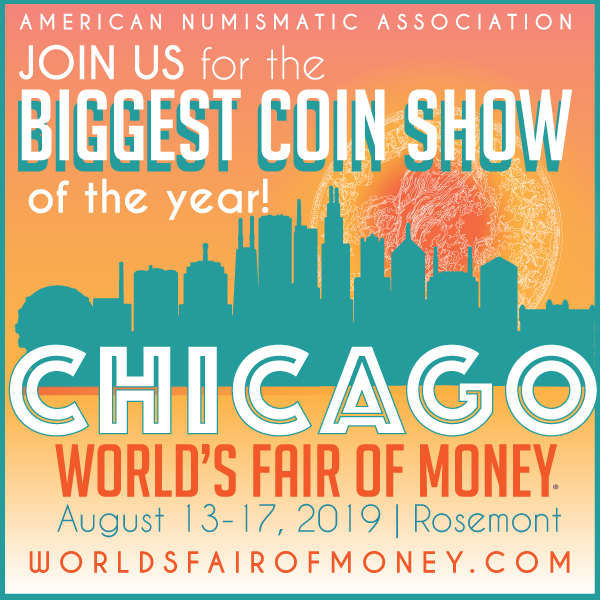
NOTES FROM E-SYLUM READERS: JUNE 23, 2019
Improving Coin Photos
Max Hensley writes:
I agree with you about pictures taken through slabs, and agree that pre-slabbing shots will be helpful.
I have always been intrigued by the effect of coin orientation on judgments of condition. Tilt a copper and it looks fabulous, change the angle of incident light and...boom...dark and dingy dog. When computer memory gets cheaper, all coins at auction would benefit from being placed on a rotary tilt table and turned mechanically, recording in high def. video or at set periods by high def stills. At its best this will highlight hairlines. Maybe someday the pics will be so go you can distinguish between cleaning hairlines (bad) and die polish marks (OK).
To read the earlier E-Sylum article, see:
HERITAGE LAUNCHES COIN IMAGE IMPROVEMENT
(https://www.coinbooks.org/v22/esylum_v22n24a11.html)
The Grade Depends on the Grader
Bob Rightmire writes:
The New York Times article (June 15, 2019) posted on The E-Sylum for all of us to read, "Retouching the Mona Lisa Is Restoration, but a Mickey Mantle? Collectors Cry Fraud" ( the print article was entitled: "A Snip, A Scrub and a Million -Dollar Scandal") has ramifications for collectors in a wide range of fields. Paul Sullivan, the author of the article quoted Gary Moser (a longtime baseball card dealer): “The grade you get, ...depends as much on the grader as on the card.” Apply that perspective to grading and authentication in other “hobbies" and you have a subtle warning that merits consideration. It should be noted for clarity that Moser has been accused of trimming rough edges of cards. He has denied the charge.
One wonders if this article exposes the tip of a widespread scandal? Caveat emptor.
To read the earlier E-Sylum article, see:
LOOSE CHANGE: JUNE 16, 2019 : Sports Card Doctoring and Conservation
(https://www.coinbooks.org/v22/esylum_v22n24a36.html)
More on Apothecary Weights
Regarding my call for information about apothecary weights in last week's issue, F. A. Liberatore writes:
 Common apothecary weights seem to sell for $1 each or less. I bought a lot of 17 for about $12 a few
years ago. The imaged weight was one I have. In fact they come in 2, 1, and 1/2 drachm (dram) weights. The 2 drachm is marked usually 3 ii or ij and
is ideally 7.776g or 6 scruples of 1.296g. The 1 dram is marked, 3i for 3 scruples, ideal weight 3.888 g and the 1/2 dram is marked 3s which I do not
understand since it weighted 1.892g or 1.5 scruples, ideal weight 1.994, so this one was about 0.6% light.
Common apothecary weights seem to sell for $1 each or less. I bought a lot of 17 for about $12 a few
years ago. The imaged weight was one I have. In fact they come in 2, 1, and 1/2 drachm (dram) weights. The 2 drachm is marked usually 3 ii or ij and
is ideally 7.776g or 6 scruples of 1.296g. The 1 dram is marked, 3i for 3 scruples, ideal weight 3.888 g and the 1/2 dram is marked 3s which I do not
understand since it weighted 1.892g or 1.5 scruples, ideal weight 1.994, so this one was about 0.6% light.
Most of mine are from Philadelphia alone or Philadelphia/NY. Makers H. Troemner, H.T. (likely same maker), and one marked JLB. The diamond with an M inside also worked in Philadelphia and NY. Three of the weights have a royal crown (Canadian origin?) and are marked in "Dram(S)" not Drachm(S) as used in Philadelphia/NY weights.
Die rotation seems common for the US weights. All the foreign weights were medal aligned. All were directly punched out of metal strips except one 2 drachm (H. Troemner) which had angled sides. There are 6 of 2 drachms, 10 of 1 drachms, and a single 1/2 drachm in the group. The 2 drachms went from 7.703 to 7.999g with a well worn outlier at 7.561g. Average weight of the remaining 5 at 7.747g expected 7.776g or about 0.4% light.
Of the 10 1 drachm weights, the one in the best condition an EF with obvious mint luster was the lightest 3.608g which is 7.2% light. (This was a dishonest weight as the variance is simply too great for a simple manufacturing variance.) The other 9 averaged 3.884g expected 3.888 with the high at 3.935 and the low 3.824, again 0.1% light. I'll be interested to hear if anyone has a reference on the apothecary weights. Happy Collecting
Thanks. I'm still curious to learn if there is a reference for apothecary weights. -Editor
To read the earlier E-Sylum article, see:
BEAUTIFUL AND UNUSUAL MONEY : Two Scruples Apothecary Weight
(https://www.coinbooks.org/v22/esylum_v22n24a31.html)
Correction: Office of Strategic Services
Regarding last week's item about Moe Berg, Mike Marotta writes:
I am sure than 20 people already told you that OSS stands for Office of Strategic Services, not "Secret" services; and the Michigan Today article is wrong.
Well, only Mike caught this one. Sorry I let it slip through - I know better. Yes, it was the Office of Strategic Services. -Editor
To read the earlier E-Sylum article, see:
MOE BERG: THE SPY BEHIND HOME PLATE
(https://www.coinbooks.org/v22/esylum_v22n24a28.html)
Coin Shop Competition: Best Security Guard
Gary Beals of Segovia, Spain writes:
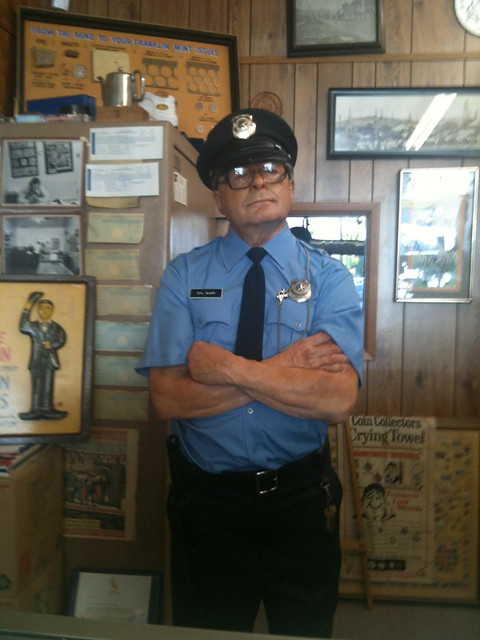 David Pickup urges a competition of coin shops and notes: “I realise there is a need for security and a camera
controlled lock on the door is needed as well as internal CCTV, but jewellers and banks probably have higher levels of security and manage to be
welcoming and informative…. You can still have good security systems and be welcoming.”
David Pickup urges a competition of coin shops and notes: “I realise there is a need for security and a camera
controlled lock on the door is needed as well as internal CCTV, but jewellers and banks probably have higher levels of security and manage to be
welcoming and informative…. You can still have good security systems and be welcoming.”
This photo, taken by me in a Fullerton CA coin shop in 2014 represents the best example of numismatic security arrangements. This chap comes across as a serious but amiable guard, well dressed and attentive.
Only one thing: He is not real. He is an alarmingly precise dummy of a person, visible to visitors from the shop window. Like a favorite rare coin, you just can't take your eyes off this guy.
That's hilarious. I'm an "alarmingly precise dummy of a person" myself, so this guy feels like family. The shop owner clearly has a sense of humor. I should order one of those "Coin collector crying towels" in the background. Thanks, Gary. -Editor
To read the earlier E-Sylum article, see:
COIN SHOP COMPETITION PROPOSED
(https://www.coinbooks.org/v22/esylum_v22n24a21.html)
NEW COIN SHOP IN ADELAIDE
Here's a sure-fire entrant in the coin shop competition proposed by Gary Beals last week. The Australian Coin Collecting Blog had heartening news today for collectors worldwide - the opening of a new coin shop, the Purple Penny. Congratulations! -Editor

We did it. One thing. A huge thing. We, as writers of this Blog and owners of The Purple Penny opened a coin shop. It's that thing you discuss that's a dream and “we'd like to do that one day”. Well we did -it was now or never, a bucket list thing. A real physical shop with glass cabinets, an EFTPOS machine named Albert and trading hours that must be adhered to. The relaxed northern suburb of Adelaide, named after Sir Douglas Mawson, 'Mawson Lakes' is the new home of The Purple Penny.
Facebook followers of The Purple Penny took the build journey with us from cramped psychologist offices to an open showroom and designated areas for the business to grow. A meeting room, office, storage room, packing room and a teeny kitchen make up The PP's new digs. Sorry we've been so quiet lately but you can see now what we've been up to.

Located at shop 2, 2-4 Hurtle Parade Mawson Lakes the coin shop opened with much fanfare including a live cross on Facebook's “The Gravy Train” coin collecting group. Purple balloons helped customers and visitors locate the new coin store and were welcomed by guide dog pup in training Tully in a fitting purple (RSB) coat. The new coin shop is open Wednesdays to Fridays 10am to 4pm and Saturdays 9am to 1pm. If you are in Adelaide and are interested in coin collecting or have anything to sell -coins, stamps, gold coins, silver, old coins, medals, tokens, military items then we'd love to see you. We are just a short walk (500m) from Mawson Lakes (bus and train) interchange so we're easily accessible from all areas of the city and surrounds. Mawson Lakes is also a great place to sit by the lakes with a fish and chip lunch or a packed cheese sandwich and thermos.

To read the complete article, see:
New Coin Shop in Adelaide
(https://www.australian-coins.com/collecting-coins/new-coin-shop-in-adelaide/)
To read the earlier E-Sylum article, see:
COIN SHOP COMPETITION PROPOSED
(https://www.coinbooks.org/v22/esylum_v22n24a21.html)

ON MEDALISTS AND MEDALLISTS
Regarding an item in my Numismatic Diary last week, Gary Beals writes:
 You got the spelling right — the Society of Medallists got it wrong.
You got the spelling right — the Society of Medallists got it wrong.
According to my amigo and technical editor, Dick Johnson, a medalist (with one L) is the winner of a medal and a medallist (with two Ls) is a designer of medals. I believe him and I listed the two words this way in Numiscadero, my Spanish to English Numismatic Dictionary (sorry for the plug).
So how did the organization itself get this wrong in large type of the cover of its own piece?
This submitted by me, one of the poorest spellers who still claims to be a journalist.
Well, the publication was produced by Tom Uram to accompany his exhibit. I hadn't noticed the spelling, and wasn't actually consciously using two L's or I would have mentioned it- that's just how it came off my fingertips. There are plenty of people in the hobby who would use the one and two L spellings interchangeably. Here's Dick's dictionary entry. -Editor
Medalist, Medallist. A designer, engraver, maker or collector of medals; one knowledgeable in medals; also a recipient of a medal. As a creator of medallic art, the medalist must not only be a highly creative artist but also know the many techniques in the field. This talented person must be proficient in producing the patterns required for any medallic item and the working knowledge must include design, relief, the capabilities and limitations of die striking and art casting, and, certainly, patina finishes.
The first medalist was Pisanello, who in 1438 created the first sculpture of what was to be called a pendant medal, a portrait of John Palaeologus. Early medalists had to prepare the entire production of a medal, from pattern to casting the final item, and to patina it. They had to know – and do – every step themselves.
With the introduction of the screw presses for striking coins, in 1530, medals were also struck, but the diameter was necessarily small. Few medalists existed at this time. Those that did had to do their own engraving, by hand, and have some mint strike their creations. Thus medalists were concentrated at the national mints of Italy, France and England. One enterprising medalist from Belgium (a doctor!), Joseph Pierre Braemt (1796-1864) in 1824 even developed his own reducing machine, where he could model oversize and cut a medal die on his machine.
Medalists since then have increased in number, as the appeal and demand for medallic art spread. It should be noted however, medalists have always been resourceful. This is lessened somewhat today with the ease of having private mints and medal makers produce what the medalist creates in his own workshop.
Famous medalists. In addition to Pisanello, famous early medalists include Donatello, Leonardo da Vinci, Benvenuto Cellini, Leone Leoni, all Italians, and somewhat later, the German artist Albert Durer. In England Benedetto Pistrucci and the Wyon family of engravers were most noted. French medalists of note is quite lengthy, but mention should be made of David d'Angers, Augustin Dupré, Charpenter, Louis Roty, others. In America: Augustus St-Gaudens, Daniel Chester French, Guston Borglum, Herbert Adams, Laua Gardin and James Earle Fraser, Paul Manship, Frederick Macmonnies, Victor David Brenner, Anna Hyatt Huntington, many others, were famed for their medallic work.
For other meanings of medalist see MEDAL COLLECTING and RECIPIENT. The word is spelled with one or two lls – both are correct.
The bolding on the last sentence is mine. So while Dick may prefer to use one or two L's himself depending on the meaning intended, his Encyclopedia does state that the two versions are both correct and interchangeable.
But how did the society itself spell it? That would be the definitive spelling for any reference to the organization or its medals. -Editor
To read the complete article on the Newman Numismatic Portal, see:
Medalist, Medallist (https://nnp.wustl.edu/library/dictionarydetail/516291)
To read the earlier E-Sylum article, see:
WAYNE'S NUMISMATIC DIARY: JUNE 16, 2019
(https://www.coinbooks.org/v22/esylum_v22n24a25.html)
VOCABULARY TERM: NUMBERING SYSTEM
Dick Johnson submitted this entry from his Encyclopedia of Coin and Medal Terminology. Thanks. Bibliophiles will appreciate this one. -Editor
Numbering System. A plan by which numismatic items are assigned a catalog number once they have been identified and arranged. A variety of systems have been used in numismatic literature including such number systems as straight numerical, open numerical, outline, straight decimal, consecutive decimal, letter-number combination, numerical coding for data processing (often with zeros in front of integral numbers), or a variety of alpha-numeric combinations of these. The choice of the number system is always that of the cataloger (who should chose the best system to accommodate the numismatic items being cataloged). Numismatic items with a lot of varieties require a different system, for example, from that with a run of one-of-a-kind items.
Problems for all number systems exist by the appearance of newly found items which should be included in the number scheme. These can be inserted if numbers were left unassigned (called open numeric), or by adding a suffix of some kind. Those that appear at the end can easily be added (called open ended).
Because of the two-sided nature of numismatic items and the ease of muling, some numbering systems have more than one element. Multiple-element numbers can incorporate obverse and reverse designations or other sets of data. A tip for multiple-element numbers: no spaces between the elements. Connect the elements with a dash, slash, or even periods.
Museums use assession numbers to identify objects in their collections. These are a type of numbering system. They often incorporate the last two digits of the year when the item was received but creates a problem when the institution becomes over 100 years old.
Citing Catalog Numbers
Using the numbers assigned by numismatic authors to specific catalog varieties – with or without their name or initials attached – is not a violation
of their copyright. It is not necessary to obtain the author's or publisher's permission to cite these reference numbers in any numismatic
writing.
Copyright technically is the arrangement of wording. In common usage these catalog numbers are a single word and no one can copyright a single word. They are in public domain and can be used by anyone at any time.
The Krause-Mishler "KM" numbers for world coins are one popular numismatic numbering system. In U.S. Large Cents the Sheldon "S" numbering system reigns supreme. Nearly every numismatic book author creates or references some sort of numbering scheme to provide a shorthand reference to items. -Editor
Looking for the meaning of a numismatic word, or the description of a term? Try the Newman Numismatic Portal's Numismatic Dictionary at: https://nnp.wustl.edu/library/dictionary
Or if you would like a printed copy of the complete Encyclopedia, it is available. There are 1,854 terms, on 678 pages, in The Encyclopedia of Coin and Medal Technology. Even running two a week would require more than 19 years to publish them all. If you would like an advance draft of this vital reference work it may be obtained from the author for your check of $50 sent postpaid. Dick Johnson, 139 Thompson Drive, Torrington, CT 06790.
THE MICHIGAN COIN COMPANY
 Michigan Coin Company, 176 Cass Street, Grand Rapids, Michigan (1888-1889), was a coin, stamp, and
curio dealership initially formed by the partnership of two teens : George Barnett Ward (1873-1935), manager, and Louis B. Bentley, a native of
Missouri, secretary and treasurer. Later on Wilbur M. Miller (1871-1958) became associated with them in business. Ward was the principal character of
Michigan Coin Company, who continued his numismatic career lifelong. Louis B. Bentley, worked as a secretary for the Peninsular Electric Company,
Grand Rapids, Michigan. From 1889 to 1890, he lived at 353 South Lafayette Street, Grand Rapids, Michigan. Nothing more is heard of him in numismatic
circles.
Michigan Coin Company, 176 Cass Street, Grand Rapids, Michigan (1888-1889), was a coin, stamp, and
curio dealership initially formed by the partnership of two teens : George Barnett Ward (1873-1935), manager, and Louis B. Bentley, a native of
Missouri, secretary and treasurer. Later on Wilbur M. Miller (1871-1958) became associated with them in business. Ward was the principal character of
Michigan Coin Company, who continued his numismatic career lifelong. Louis B. Bentley, worked as a secretary for the Peninsular Electric Company,
Grand Rapids, Michigan. From 1889 to 1890, he lived at 353 South Lafayette Street, Grand Rapids, Michigan. Nothing more is heard of him in numismatic
circles.
George Barnett Ward (1873-1935), was born on April 30, 1873, in Spring Lake, Ottawa County, Michigan, youngest of three sons of Alfred Ward (1829-1893), a Gardner from Vermont, and Mary Elizabeth Burnapp Ward (1838-1897).
In the fall or winter of 1888 he traded as Michigan Coin Company from his parents home. Dr. George Heath, M.D., began his American Numismatist magazine in August 1888, just 140 miles south west of Grand Rapids, which served as a catalyst inspiring young Ward to form his fledgling company. This seems to be confirmed by the fact that Ward was a charter member of the ANA. Also, one wonders if Heath refers to George Ward or his father Alfred who was from Vermont when he mentions "Brother Ward, of Vermont, lately bought a box of over 200 copper coins for $4.50. Inside of twenty-four hours he was offered $25 for his bargain, and later was offered $5 each for some of them singly." George Heath, "With the Editor," The Numismatist, Vol. IX, No. 1, January (1896) : 28
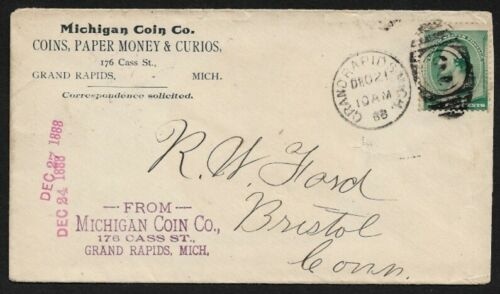 He lived with his parents at 176 Cass Street, Grand Rapids, Michigan.
He lived with his parents at 176 Cass Street, Grand Rapids, Michigan.
He was an officer of the Templars, South Enterprise Lodge, No. 20, Grand Rapids, Michigan.
On February 23, 1892, he married Bertie E. Lamoraux of New York. They had a daughter Gladys (1892-1963), and a son Franklin William Ward (1896-). They were divorced April 3, 1900.
In 1892, he was a charter member of the ANA being ANA Member No. 33.
By 1897, he worked as a photographer and sold photograph equipment and supplies living and working in Chicago.
On April 28, 1900, 3-1/2 weeks after his divorce he remarried to Lillian May Witwer (1866-1951).
He reapplied for membership to the ANA in September 1907.
He moved to 1725 Hinman Avenue, Evanston, Illinois and again reapplied for ANA membership in August 1913, becoming ANA Member No. 1720 in September.
He remarried to Evelyn M. Hart (1876-). They had a son William Richard Ward (1918-1997).
Ward was elected an associate member of the ANS in April 1914.
He was a member of the Evanston Country Club.
In 1920, he lived in Palos, Illinois.
The 1930 U. S . Census lists him as the owner of a restaurant in Palos Park, Cook County, Illinois.
He died on April 10, 1935, Palos Park, Cook County, Illinois.
To read the complete article, see:
MICHIGAN COIN COMPANY
(https://sites.google.com/a/numismaticmall.com/www/numismaticmall-com/michigan-coin-company)
The entire inventory of the Lupia Numismatic Library is for sale. Individual items will be available before the remaining archives are broken up into parcels sold at philatelic auctions in the U. S. and Hong Kong. Check NumismaticMall.com frequently as dozens of new items with estimates will be posted daily until everything is sold.
All inquiries will be given prompt and courteous attention. Write to: john@numismaticmall.com .

THE GREAT PRECIOUS METALS BOOM AND BUST
Martin Kaplan pointed out this blog post by Jeff Garrett on the NGC site. It discusses how gold prices affect the coin industry, and along the way he highlights the history of the precious metals boom in the late 1970s. Here's an excerpt. -Editor
By the late 1970s inflation had become the No. 1 problem in the United States. The numismatic world was about to change almost overnight! Gold and silver prices began a sharp rise in the middle part of 1979, and by January 1980, prices had peaked to over $850 for gold and nearly $50 for silver. Famously, the Hunt Brothers had attempted to corner the market for silver. Prices nearly quadrupled in a few months. This began one of the most exciting booms to ever hit the numismatic world.
Anyone with a coin shop now was making fantastic sums of money. Most were greeted each morning with lines around the corner of individuals desperate to cash in. The only limit on how much money that could be made was capitalization. Many dealers were out of money by lunchtime. The public was selling anything and everything made of silver. Sterling sets that had been in the family for generations were now headed to the refinery. I still have an incredibly beautiful champagne bucket that I rescued from a shipment.
The large crowds of sellers also brought rare coins with them. Coins were now in the spotlight like never before. Incredible collections, coin hoards, and numismatic delicacies were now coming over the counter in record numbers. Many of the great rarities seen today made their first appearance during this time. The unique 1870-S Half Dime was somehow sold over the counter in a Chicago coin shop and later discovered in a junk box. These were truly exciting times in the rare coin market.
Unfortunately, the gold and silver boom was very short-lived. By March 1980, silver had fallen to below $11 per ounce again. Obviously, speculation had played a large role in the rise of gold and silver at the time. The numismatic impact of the 1980 gold and silver boom was multi-faceted. Coin prices soared along with metal prices. Many rare coins traded hands for prices that would not be seen again for two decades.
The absolute peak was the auction sale of the Garrett (no relation) Collection. Coins were bringing six-figure prices with regularity. Most of the buyers were rare coin dealers who were newly minted millionaires from precious metals trading. This was a very exciting time to be a rare coin dealer.
Many of today's household names in the numismatic world were very young, making incredible sums and living large! Like someone who had won the lottery, a few could not handle the newfound wealth and lost it all due to drugs, gambling and a decadent lifestyle. Maybe someday, someone will write a book about this incredible part of numismatic history. It would make a great movie!
Like Jeff, I was getting my start in the hobby in the late 70s, but as a collector, not a dealer. I saw those crazy lines outside coin shops. I was new and bewildered, but certainly felt the excitement. I'm sure many of our readers have great stories from those days - let's hear some of them. Where were YOU when the market rose and fell? -Editor
To read the complete article, see:
Jeff Garrett: The Rising Gold Tide (https://www.ngccoin.com/news/article/7523/)
THE TREASURE OF AMERSFOORT
Aaron Oppenheim writes:
Here's an interesting tidbit on dealer Jacob Schulman from a history of the Jewish community in Amersfoort, Holland.
In 1894, with the rebuilding of the house of Anna van der Heijden in the Nieuwstraat a special discovery was made, which consisted of one big and two small jars with gold- and silver coins. The big jar contained 12.800 kilograms gold coins; the two small ones had together 9.900 kilograms of silver coins; the gold coins were all undamaged, the silver ones were mostly oxidized.
They called the specialist Jacob Schulman. He immediately saw that there were a few very exceptional pieces. The oldest coin was from 1504 and the youngest from 1558. So the treasure must have been hidden for about 330 years. On the 26th of February the coins were temporarily moved to the Royal Cabinet of coins, medals and engraved stones in The Hague, where they were described and on July 18, 1894, they were sold in Amsterdam.
Jacob Schulman came originally from Hilversum and his hobby was assembling coins from the then Dutch-Indies, and medals. From his hobby he made a profession. His big specialties were Eastern coins and coins from Portugal/Brazil and the rest of South-America. In 1880 he published his first catalogue of Dutch coins. His numismatics workshop was in the Langestraat (now no. 28), corner Lieve Vrouwenstraat. In 1889 he held his first coin-auction in his own name. Five years later he sold a big part of the Amersfoort coin-treasure. Because of all these activities, the place in Amersfoort became too small, and it was moved to Amsterdam in 1902, where his sons came into the business, they became notorious far beyond the Dutch borders.
An interesting detail to report is that in addition to his work Jacob Schulman was the secretary (from 1882-1883) of the archaeological society Flehite from 1882-1883.
Thanks! Great story. I wonder where some of those coins are today. -Editor
To read the complete article, see:
Jewish life in Amersfoort
(https://www.dutchjewry.org/amersfoort/jewish_life_in_amersfoort.shtml)
COIN BOARD TYPE SET EXHIBIT
In the Summer 2019 issue of his Coin Board News newsletter, Dave Lange published images of a recent coin show exhibit of coin boards. -Editor

SHARING THE HOBBY In April, board collectors Don and Marie Kocken proudly displayed many of their boards, folders and albums in a grand exhibit at the N.O.W. (Numismatists of Wisconsin) coin show in Green Bay. Too extensive for a glass case, the boards were mounted on table top, fold-out panels that seemed to go on for miles. Thanks to Don and Marie for putting this together and to Jeff Reichenberger for his photos of the event.

Thanks to Dave, Jeff and especially the Kockens for assembling and displaying such a great collection. Impressive! -Editor
To visit Dave's web site, see:
http://www.coincollectingboards.com/

TIRUCHIRAPPALLI INDIA COIN SHOW
Coin shows take place the world over. Here's a report from The Hindu on a show in Tiruchirappalli, India. -Editor
 An exhibition of old coins, paper currencies and unique banknotes organised by Tiruchi Notaphily Society
in the city has attracted schoolchildren and enthusiasts in droves.
An exhibition of old coins, paper currencies and unique banknotes organised by Tiruchi Notaphily Society
in the city has attracted schoolchildren and enthusiasts in droves.
The visitors learn something new from each of the 50 stalls at the three-day exhibition at Srinivasa Hall culminating on Sunday.
Yoganandini Vignesh, an avid collector who has displayed 'animal notes' and 'nature notes', currency notes with flora and fauna on them, said that choosing a theme and collecting the notes add more excitement to the hobby.
Mohammed Zuber, a coin collector, displayed unique coins from various rulers and their dynasties. The Bijapur Sultan in the 1600s made hairpin coins which women would wear on their hair and smuggle it into other countries, said Mr. Zuber.
"Coins as small as the top of a pin were minted. These are difficult to find but hold very important significance," he said.
'Coins of Dindigul Region', a book written by Karthick Chandrasekar, was released at the event.
I was unable to locate more information online about this new book; perhaps something will surface in the weeks ahead. -Editor
To read the complete article, see:
Old coins
and paper currencies exhibition draws curious visitors
(https://www.thehindu.com/news/cities/Tiruchirapalli/old-coins-and-paper-currencies-exhibition-draws-curious-visitors/article27955139.ece)
JUNE 2019 HONG KONG FAIR EDUCATIONAL SYMPOSIUM
The upcoming Hong Kong International Numismatic Fair features an educational symposium. -Editor
Numismatic Guaranty Corporation™ (NGC®), Numismatic Conservation Services™ (NCS®) and Paper Money Guaranty™ (PMG®) are sponsoring an educational symposium at the Hong Kong International Numismatic Fair (HKINF). The symposium will be held Saturday, June 29, at the Mira Hotel, 3rd Floor.
Coin and paper money collectors and dealers will have the opportunity to learn more about numismatics from experts in their fields during these three presentations:
2pm – “Polymer Banknotes – The Future of Banknotes,” Stane Straus, Polymer Banknotes Expert
 Stane Straus is an
expert on polymer banknotes and is managing director of PBN Ltd. He travels extensively overseas and maintains relationships with central banks and
banknote printers around the world. He has advised central banks on banknote printing and on conversion to polymer notes.
Stane Straus is an
expert on polymer banknotes and is managing director of PBN Ltd. He travels extensively overseas and maintains relationships with central banks and
banknote printers around the world. He has advised central banks on banknote printing and on conversion to polymer notes.
3pm – “Collecting Modern Chinese Coins,” King L Chan, Modern Chinese Coins Expert
 King L Chan is a
modern Chinese coins expert who has written several books and is co-author of "Gold & Silver Coins of China: Standard Catalogue,
1979-2017." He is a renowned Chinese numismatic scholar and a senior NGC consultant.
King L Chan is a
modern Chinese coins expert who has written several books and is co-author of "Gold & Silver Coins of China: Standard Catalogue,
1979-2017." He is a renowned Chinese numismatic scholar and a senior NGC consultant.
4pm – “NGC and PMG: Expert and Impartial Certification,” David Camire, NCS President and NGC Grading Finalizer, and Adam Howerton, PMG Grading
Finalizer
 David J. Camire
specializes in modern Chinese coins and is considered an authority on mint errors. Before joining NGC in 1999, David was a numismatist with one of
the largest coin companies. He is the co-author of "100 Greatest U.S. Error Coins."
David J. Camire
specializes in modern Chinese coins and is considered an authority on mint errors. Before joining NGC in 1999, David was a numismatist with one of
the largest coin companies. He is the co-author of "100 Greatest U.S. Error Coins."
 Adam Howerton is
one of the most senior members of PMG's paper money grading team. Before joining PMG in 2011, Adam was a graduate and research assistant at the
University of South Florida in Tampa, where he completed a master's degree in US cultural history.
Adam Howerton is
one of the most senior members of PMG's paper money grading team. Before joining PMG in 2011, Adam was a graduate and research assistant at the
University of South Florida in Tampa, where he completed a master's degree in US cultural history.
To read the complete article, see:
NGC, NCS and PMG Sponsoring Hong Kong Symposium on June 29
(https://www.pmgnotes.com/news/article/7468/hong-kong-symposium-june-2019/)
JUDAEAN COINS FROM THE MOUSSAIEFF COLLECTION
Here's a press release about the Judaean Coins in the recent Goldberg sale. -Editor
Sold by Goldberg Auctioneers June 4, 2019
Goldberg Auctioneers have probably hammered down more ancient Judaean coins than anyone else. Their Pre-Long Beach Auction of The Moussaief Collection Part II featured over 200 coins ranging from Alexander the Great issues struck in Judaea during his lifetime (336-323 BCE) and afterwards, to coins issued by Simon Bar Kochba during the failed Second Revolt (132-135 CE), and some Judaea City Coins made by the Romans in the following decades.

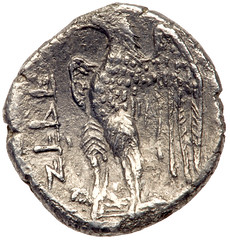
An example of the early coins sold was issued during the Ptolemaic occupation (285-246 BCE) by Ptolemy II Philadelphos. The tiny silver Hemidrachm, weighing a mere 1.49 gm. sold for $21,000, more than double the $10,000+ estimate. It was described as: i>Diademed head of Ptolemy I right. Reverse: 'YHDH' (paleo-Hebrew), eagle with wings displayed standing left on thunderbolt. Hendin 1085; TJC 31a. Extremely Rare. Toned. Choice Very Fine. Only a small handful of this denomination survive.
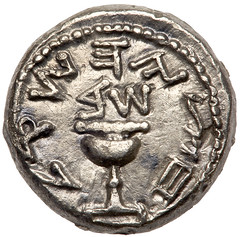

No respectable Judaean coin auction would be complete without the famous silver Shekels issued during the First Revolt (66-70 CE), and Moussaieff II contained a total of 11 Shekels and Half Shekels issued during the first three years of the war. The star performer in this category was a Year Two (67/8 CE) Half Shekel that brought $20,000 vs. the $9,000+ estimate. It was described in the catalog as: 'Half of a shekel' (Paleo-Hebrew), ritual chalice with pearled rim, the base raised by projections on both ends; above, 'year 2'. Reverse: 'Jerusalem the holy' (Paleo- Hebrew), staff with three pomegranate buds, round base. Hendin 1359; TJC 195. Well struck and nicely centered. Traces of luster still present. Extremely Fine.


Moussaieff II featured a number of coins that the Romans issued following the end of the First Revolt (in 70 CE)—the famous Judaea Capta series. A bronze Sestertius, with remarkable detail in the portraits of the standing Emperor Vespasian and the seated woman (representing Judaea) brought $12,000, triple the estimate of $4,000+. The coin was described as: Rome, 71 CE. IMP CAES VESPASIAN AVG P M TR P P P COS III, laureate head of Vespasian right. Reverse: IVDAEA CAPTA, S C in exergue, palm tree; to left, emperor standing right, foot on helmet, holding spear and parazonium; to right, Jewess in attitude of mourning seated right on cuirass. Hendin 1504; RIC 167; BN 497-8; BMC 543. Smoothed and with tooling, dark patination. About Extremely Fine.


Goldberg's Pre-Long Beach Sale featured over 75 coins issued during the Second Revolt (132- 5 CE), mostly silver Selas (Tetradrachms) and Zuzim (Denarii). All of these issues are struck over Roman coins. One of the most dramatic overstrikes was evident in a Zus, described as follows: Undated, attributed to year 3 (134/5 CE). 'Simon' (Paleo-Hebrew), bunch of grapes with leaf and tendril. Rev. 'For the freedom of Jerusalem' (Paleo-Hebrew), upright palm branch. Hendin 1430; Mildenberg 170 (O21/R103); TJC 272c. Struck on a denarius of Titus with a clear portrait of the emperor. Toned. Basically as struck. Sharpness of Very Fine / Extremely Fine. From the Palm Desert Collection. The estimate value was $1,000+, and it sold for $2,300.


The very first Second Revolt coin from the Moussaieff Collection brought the highest winning bid in this group--$77,500, exceeding Goldberg's estimate of $75,000. It was headed 'Magnificent' in the catalog, and described as: 'Jerusalem' (Paleo-Hebrew), tetrastyle façade of the Temple of Jerusalem; show bread table or Ark of the Covenant in chest form with semicircular lid and short legs, seen from a narrow side. Rev. 'Year one of the redemption of Israel' (Paleo-Hebrew), lulav with etrog at left. Hendin 1373; Mildenberg 1 (O1/R3); TJC 218. Very rare. An absolutely incredible example! Boldly struck and well centered with nice wide margins. Virtually as struck! Traces of luster still evident. One of the finest in existence. Superb Extremely Fine.
All of the Judaean and other coins in Goldberg's June 4-5 sale can be viewed at www.goldbergcoins.com/view-auctions/catalog/id/67/?page=1 .
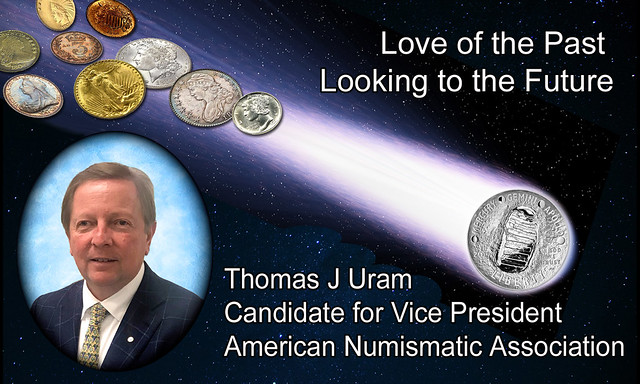
MORTON & EDEN JUNE 2019 SALE SELECTIONS
Morton & Eden in London have a small collection of U.S. coins coming up in a sale this week (lots 523-573). Here are some selections. -Editor
Lot 534: 1/24th Real Plantation Token
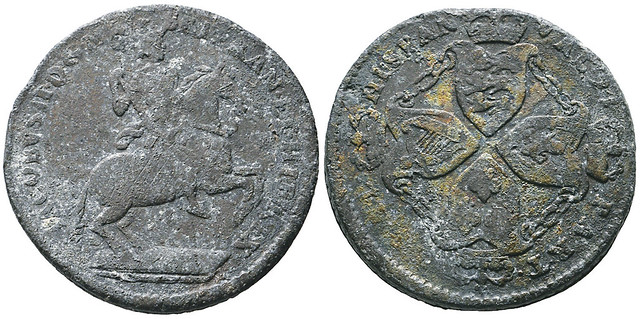
Colonial America, James II, tin 1/24th real Plantation token, undated (1688), king on rearing horse right, legend reads hib, rev., cruciform crowned shields joined by chains, with sideways 4 in 24, edge engrailed with circular dot pattern (dies 8/C), typical black oxidization and corrosion, fair to fine. from a different property to the rest of the collection; discovered on the Thames foreshore in London, 2016. (400-600 GBP)
To read the complete lot description, see:
https://www.numisbids.com/n.php?p=lot&sid=3274&lot=534
Lot 550: 1851 Half Cent
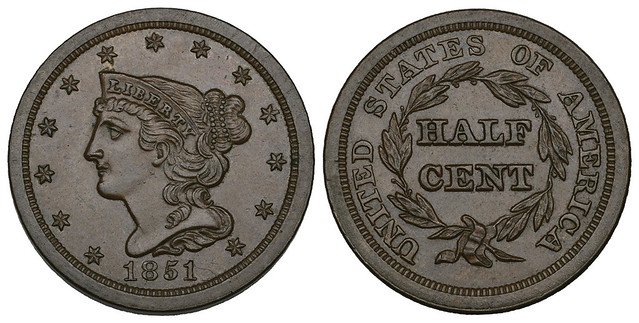
U.S.A., half-cent, 1851, virtually as struck, with rich, chocolate tone, in PCGS holder graded MS63BN (150-200 GBP)
To read the complete lot description, see:
https://www.numisbids.com/n.php?p=lot&sid=3274&lot=550
Lot 560: 1895 Proof Barber Dime
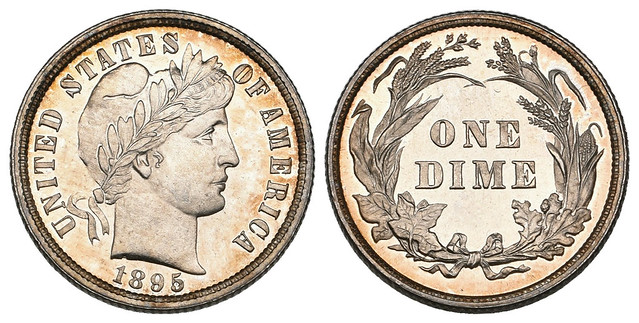
U.S.A., proof dime, 1895, an essentially flawless gem mint state example with light gold toning to the fully reflective surfaces, in PCGS holder graded PR66CA (650-850 GBP)
To read the complete lot description, see:
https://www.numisbids.com/n.php?p=lot&sid=3274&lot=560
Lot 572: 1871 Proof Half Dollar

U.S.A., proof half-dollar, 1871, a beautiful deep cameo example partially toned at peripheries, in PCGS holder graded PR64+DC (800-1200 GBP)
To read the complete lot description, see:
https://www.numisbids.com/n.php?p=lot&sid=3274&lot=572
Lot 528: 1878-CC Half Eagle

U.S.A., 5 dollars, 1878 CC, Carson City mint, scuffed and with surface scratches, good very fine to extremely fine and rare, in PCGS holder graded AU50 (6000-8000 GBP)
To read the complete lot description, see:
https://www.numisbids.com/n.php?p=lot&sid=3274&lot=528
Here's a smattering of other lots in the sale. -Editor
Lot 1024: Spanish Silver and Copper Issues

Spain, Fernando VII, miscellaneous silver and copper issues, Mallorca (Palma), 30 sous (4), 1808 (2), one octagonal, 1821 (2), one with FR: VII inverted, this toned, weakly struck, very fine for this but with possible traces of edge mounting; 5-pesetas, 1823 (2), one YND, Santander, 10-reales, 1821, Pamplona, 8-maravedis, 1823, Segovia, 8-maravedis (14), including 1828, poor, very rare; 4-maravedis (9), 2-maravedis (16), silver almost fine to very fine, both 1808 and 1821 30 sous with light edge filing, 10 reales faint chop mark and smoothed, copper many with verdigris, poor to very fine and two contemporary brass copies of 8-maravedis, one cast (48). (i) Ex G. Bauer, Glendining, 13 December 1962, lot 842. (iv) Ex Seaby, 1968, C400. (300-400 GBP)
To read the complete lot description, see:
https://www.numisbids.com/n.php?p=lot&sid=3274&lot=1024
Lot 474: 1831 Poland November Uprising Ducat

Poland, November Uprising, ducat, 1831, 3.50g (F. 114), good extremely fine. Provenance: Count Emeryk Hutten Czapski (1897-1979), grandson and heir of the celebrated collector, numismatist and historian of the same name; hence by descent. (1000-1200 GBP)
To read the complete lot description, see:
https://www.numisbids.com/n.php?p=lot&sid=3274&lot=474
Lot 837: 1838 Germany Ludwig I Gold Medal
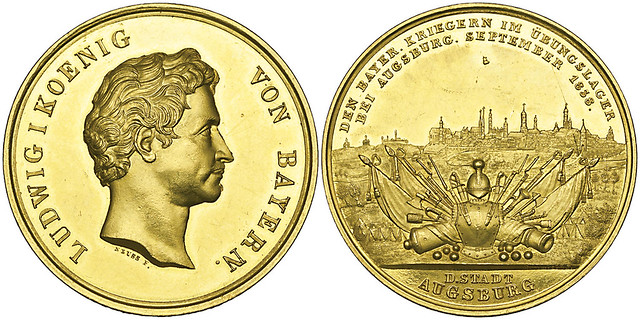
Germany, Bavaria, Ludwig I, Army Manoeuvres in Augsburg, September 1838, gold medal, by Neuss and Rabausch, bare head right, rev., large trophy of arms before army encampment with view of Augsburg behind, 40.8mm, 33.44g (Witt. 2675), surface scratches and scuffs in fields, otherwise extremely fine and with prooflike surfaces, very rare. Ex Numismatik Lanz, 26 November 1985, lot 459. (4000-6000 GBP)
To read the complete lot description, see:
https://www.numisbids.com/n.php?p=lot&sid=3274&lot=837
FOURTH CENTURY BRONZE COINS FOUND IN PARION
Found via The Explorator newsletter, this article describes preservation and restoration work on coins found in Parion. -Editor

During the excavations in the ancient city of Parion - the port city of the Roman Empire 2,700 years ago - 466 bronze coins have been found.
The preservation and restoration work on the coins have been continuing in the laboratory, and they provide information about the destruction of the defense walls surrounding the ancient city.
“We already thought that there was a Goth invasion in the last quarter of the third century in the city. The presence of these coins is important to support this argument,” said archaeologist Sadik Sulan, deputy head of excavations.
The excavations started in 2005 the old port city, located in Kemer village in the Biga district in the northwestern province of Çanakkale, and have been continuing with a team headed by Professor Vedat Keles of Samsun's Nineteen May University.
“These works are carried out by going down to the certain levels, and we unearth the finds. These include both ceramic and sculpture pieces. We recently found 466 coins in a terracotta pot. Unfortunately, these bronze coins are in poor condition. Following the preliminary examination of our head Vedat Keles, who is also a numismatist, we saw that there was a coin belonging to the fourth century, the Valentinian period. These coins are actively and passively protected by conservators in the laboratory. They will be evaluated by experts and presented to the world of science. These coins are very important to us. We thought that there was a Goth (people from the north) invasion in the last quarter of the third century in the city. The presence of these coins is important in support of this argument. It is also important for the dating of the city wall to understand the phases of the ancient city of Parion. There is an important phase of destruction. Destruction occurred in the fourth and fifth centuries. It will be important for the region to solve this. Parion will be an important center for the region and country as a tourism destination.”
To read the complete article, see:
Bronze coins shed light on Parion's history
(http://www.hurriyetdailynews.com/bronze-coins-shed-light-on-parions-history-144271)
CARAUSIUS DENARIUS FOUND 30 YEARS AGO OFFERED
Philip Mernick passed along this Daily Mail story about a man's long-ago coin find that turned out to be valuable. Thanks. -Editor
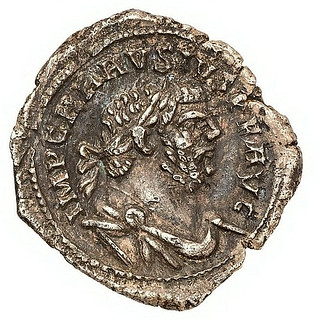
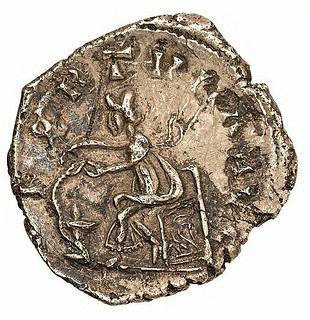
A Roman coin found by a metal detectorist 30 years ago has been revealed to be 2,000 years old and worth £10,000.
Tom Thomas, 62, kept the coin as part of an amateur collection until he was persuaded by a friend to take it to experts for valuation two years ago.
The retired policeman from Reading, Berkshire, said: 'I knew it to be a Roman coin as I had found others in the past. I put it with my small collection and thought nothing more of it.
'I've been metal detecting for more than 30 years and I've found lots of different coins and other Roman artefacts.
'It turned out to be the only one of its kind in the world.
'Mark contacted other experts, including the British Museum, and no-one had seen anything else like it before.'
The coin, which was dug up in a farmer's field in Berkshire and dates back to AD 286-93, is now set to go up for sale at Hansons Auctioneers, in Derbyshire with a guide price of £10,000.
The coin, which is registered with the Portable Antiquities Scheme (PAS), features the Roman goddess Salus feeding a snake rising from an altar.
To read the complete article, see:
Metal
detectorist, 62, discovers that a silver Roman coin he found 30 years ago is the only one of its kind and is worth £10,000
(https://www.dailymail.co.uk/sciencetech/article-7123979/Metal-detectorist-Tom-Thomas-62-discovers-silver-Roman-coin-worth-10-000.html)

THE AUSTRALIAN KANGAROO ONE TON GOLD COIN
This press release from the Perth Mint describes their colossal gold coin, which will be coming to New York to mark the debut of the Perth Mint Physical Gold Exchange Traded Fund (ETF). -Editor
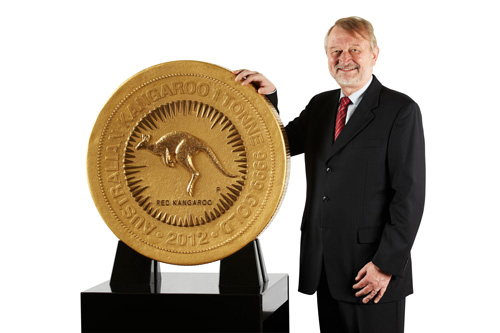
Checking in with news from The Perth Mint Physical Gold ETF – AAAU – a unique Australian gold investment product now trading on the New York Stock Exchange. To mark its official launch, the custodian of the fund – The Perth Mint – will be bringing the Australian Kangaroo One Tonne Gold Coin to the streets of New York City.
Created by The Perth Mint, a government-owned precious metals enterprise and authority on gold, the colossal coin tips the scales at 1 ton (2,205 lbs) of 99.99% pure gold. Measuring more than 30 inches in diameter and over 5 inches thick, this gold icon is worth in excess of $45 million. As the biggest, heaviest and inherently most valuable gold bullion coin in the world, it holds the title of the “largest coin” ever made by Guinness World Records. The 1 ton gold coin will be on public display in Experience Square directly outside the NYSE on July 16 only before it embarks on its journey back to Australia.
I asked the Perth Mint for some additional images and information, and here are the responses. -Editor


Can you provide additional information about the makers of the coin?
The coin was created as the showpiece of the Australian Kangaroo Gold Bullion Coin Program, by the late Dr. Stuart Devlin AO CMG, goldsmith and jeweler to Her Majesty Queen Elizabeth II.
Who designed the reverse side?
The reverse of the coin, featuring the bounding red kangaroo design was created by the internationally renowned coin designer and metalsmith, the late Dr Stuart Devlin. This same artistry has been featured on the annual kilo Australian Kangaroo gold bullion coin since the wildlife theme was introduced to the program in 1989.
The obverse of the coin features the Ian Rank-Broadley effigy of Her Majesty Queen Elizabeth II, accompanied by the inscriptions ELIZABETH II, AUSTRALIA and the monetary denomination of 1 MILLION DOLLARS.
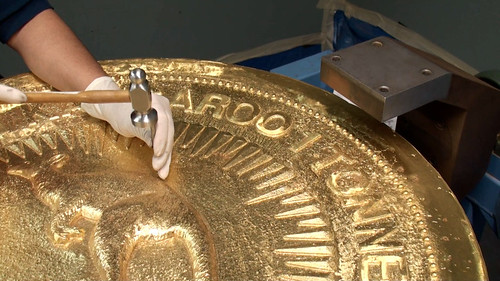
What are some of the problems that had to be overcome to create such a massive piece?
The coin took some 12 months to create from conception to completion and was formed by melting gold at a searing temperature of more than 2,192°F, presenting a number of possible challenges. Fortunately, given the size and quality of The Perth Mint's operations, combined with the expertise of our staff, we were able to successfully make a pure gold coin of this magnitude, in part, by taking the following steps:
• Ensuring that there was no interruption to our standard operations.
• Modifying our refining facilities.
• Creating a special pouring pit and graphite mold.
• Conducting trials at various stages of the project.
• Handcrafting the milled edge and manually finesse the design.

For more information on the ETF, see the prospectus:
https://aaauetf.com/static/sitepages/pdf/AAAU%20Prospectus%20with%203-31-19%2010-Q%20Supplement%20No.%202%205-17-19.pdf
WHICH TUBMAN PORTRAIT TO USE?
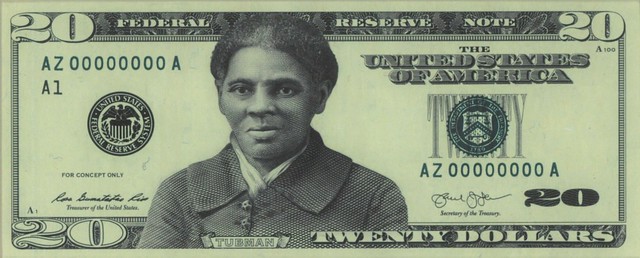
BEP Tubman Note facsimile design
Max Hensley writes:
I noticed the Tubman note facsimile and immediately thought, well, shades of the Susan B. Anthony dollar! This is the second politically active female to be transformed by the government into a battle-axe and stuck on our money. Tubman's visage is a combination of glower, sneer and frown. She looks the way my grandmother did when I came home two hours late from curfew. I suppose that is the way it was in those tough times for women (and blacks), but I have always felt the harsh depictions the government foists on us are designed to punish us retroactively for our ancestors' bad behavior or to show us how hard it was for these rights pioneers.
In any case, I don't want my money to be preaching at me, delivering a guilt-trip message about some identity group or another. I want it to be an uplifting and unifying message about my country. This curmudgeon writer would be happy with bills featuring scenes from the national parks or historical events like the Battle of Yorktown. Our current boring currency selection of big-headed officials and clunky buildings is bad, but let the special interests get on to our currency and it's gonna be a bad day indeed.
I also thought of the Anthony dollar coin debacle, where her descendants fought for a "realistic" portrait of her in old age, as they remembered her. But a portrait of her in her prime would probably have been more appropriate as well as more aesthetically pleasing.
Politics is in the eye of the beholder. I'm a political moderate and WOULD find honoring Tubman to be uplifting and unifying. I can agree with Max though that current designs are boring, and also to be wary about changing them willy-nilly. It's precisely because you can't please everyone that countries end up with bland buildings, plants and animals on their paper money.
But back to the topic of WHICH portrait to prefer, should a Tubman design ever move forward. The New Yorker had a piece on the Tubman note this week, and it also touched on the chosen image of her. Thanks to Arthur Shippee for forwarding it. -Editor
A leaked facsimile of the Tubman twenty, published in the Times last Friday, gives a sense of how far along the plan had been. The designers chose a familiar image, showing an older Tubman in a black coat with a prim white collar, her graying hair pulled back in what might be plaits. It is not a statesman's bloodless portrait; it does not project pomp or circumstance but, rather, a frisson of moral humility. Frail-seeming, Tubman is ever so slightly smiling. Her expression is a stealthy contrast to the blank-eyed stare of Jackson, who would remain on the new twenty's back side, demoted but not fully displaced.
 Looking at the bill
design, I'm reminded of a photograph of Tubman that was discovered, earlier this year, in an album that belonged to a nineteenth-century
abolitionist. It is a carte de visite—a calling card—and it features Tubman in her youth. She is draped on a chair, wearing a fashionable dress with
a bodice cinched to her waist and a voluminous skirt lavishly sweeping the floor. The image is beautifully intimidating. It vibrates with a mystique
never attributed to Tubman; if you can dispell, for a moment, the humble altruism that girdles her legend, you may notice that the portrait is almost
sexy. It's impossible to imagine fitting the glory of this Tubman onto a dollar bill. Who would dare touch her?
Looking at the bill
design, I'm reminded of a photograph of Tubman that was discovered, earlier this year, in an album that belonged to a nineteenth-century
abolitionist. It is a carte de visite—a calling card—and it features Tubman in her youth. She is draped on a chair, wearing a fashionable dress with
a bodice cinched to her waist and a voluminous skirt lavishly sweeping the floor. The image is beautifully intimidating. It vibrates with a mystique
never attributed to Tubman; if you can dispell, for a moment, the humble altruism that girdles her legend, you may notice that the portrait is almost
sexy. It's impossible to imagine fitting the glory of this Tubman onto a dollar bill. Who would dare touch her?
To read the complete article, see:
The Haunted Image of
Harriet Tubman on the Twenty-Dollar Bill
(https://www.newyorker.com/culture/cultural-comment/the-haunted-image-of-harriet-tubman-on-the-twenty-dollar-bill)

I can't help but keep coming back to the $100 J.S.G. Boggs bill shown above, picturing Harriet Tubman as a child. The younger Tubman portrait had yet to be found when this was produced in the 1990s; I would also prefer the midlife portrait. -Editor
To read the earlier E-Sylum article, see:
BEP PREPARED HARRIET TUBMAN FACSIMILE DESIGNS
(https://www.coinbooks.org/v22/esylum_v22n24a32.html)
Here's one more take on the topic from the Daily Kos, forwarded by Gary Beals. -Editor
To nobody's surprise, the decision was viewed in some right-wing quarters as politicizing our currency. Trump himself called the decision “pure political correctness,” as if no politics have been involved in previous choices of who appears on our bills and coins. He suggested Tubman should perhaps appear on the $2 bill, currency that many Americans are surprised to learn still exists.
The $2 bill does indeed still exist. Maybe a design change is the boost it needs to get into circulation. Not that it matters much what any numismatists or even plain old citizens think. -Editor
To read the complete article, see:
NYT: Mnuchin misled Congress on why Harriet Tubman's image won't appear on $20 bill anytime soon
(https://www.dailykos.com/stories/2019/6/14/1864805/-NYT-Mnunchin-misled-Congress-on-why-Harriet-Tubman-s-image-won-t-appear-on-20-bill-any-time-soon)
MORE ON THE AUSTRALIAN BANKNOTE DESIGN TYPO
A Freedom of Information request has revealed some more background on the Australian banknote typo we discussed earlier. Here's an excerpt from a Bloomberg news article. -Editor
 Australian central bank chief Philip Lowe was “relatively relaxed” about an error on the nation's new A$50 note
that was repeated four hundred million times, according to internal correspondence released under a Freedom of Information request.
Australian central bank chief Philip Lowe was “relatively relaxed” about an error on the nation's new A$50 note
that was repeated four hundred million times, according to internal correspondence released under a Freedom of Information request.
“I spoke to Phil about this,” Chris Aylmer, head of risk and compliance at the Reserve Bank of Australia, said in a Dec. 21 email, referring to Lowe. “He was relatively relaxed -- the functionality of the note has not changed and it is still legal tender,” he said, adding that the printer of the currency, Note Printing Australia, nonetheless needs to review the text approval process.
Aylmer, whose email was copied to RBA No. 2 Guy Debelle, described employees at NPA as “mortified that the error occurred.”
The banknote released last October misspells the word “responsibility” in very fine print which is only identifiable with a microscope.
The RBA, on the other hand, appeared somewhat more chilled.
“No one died,” Luke Porter, the RBA's manager of banknote production, said in the correspondence. “I'm just happy my initial email to NPA had the correct spelling.”
To read the complete article, see:
'No One Died': Australia
Central Bank Officials Relaxed About New Banknote Typo
(https://www.bloomberg.com/news/articles/2019-06-18/-no-one-died-rba-officials-relaxed-about-new-banknote-typo)
To read the earlier E-Sylum article, see:
TYPO DISCOVERED IN AUSTRALIAN BANKNOTE DESIGN
(https://www.coinbooks.org/v22/esylum_v22n19a29.html)
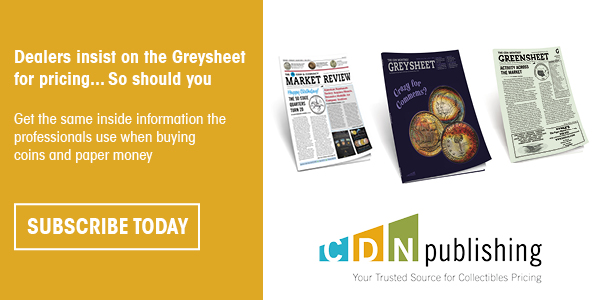
ARTIST CREATES BREXIT BANKNOTE
This article from the Hackney Citizen describes a local artist's Brexit banknote. -Editor

Kevin Gill at his studio with The Brexit Note.
A Homerton artist's double-sided painting of a banknote featuring politicians closely associated with Brexit has been “delightfully received” by outgoing Prime Minister Theresa May.
Kevin Gill, 23, whose 2016 artwork of Barack Obama on a billion-dollar note won praise from the former president himself, started work on a piece exploring the UK's relationship with the European Union last December.
The Brexit Note shows Theresa May, Boris Johnson, Nigel Farage, David Davis, Jeremy Corbyn and David Cameron facing European leaders including Jean-Claude Juncker, Donald Tusk and Angela Merkel.
Splitting them is a map of the UK, divided into red and blue – the colours of the opposing referendum campaigns.

The reverse, a Euro note, focuses on the beginnings of Britain's ties to the EU, with some of the union's founding fathers lining up alongside former prime ministers Winston Churchill and Ted Heath, under whose premiership the UK joined in 1973. It also details a list of treaties signed by the UK over the past 46 years as part of its commitment to the union.
Hackney-born Kevin says the oil-on-canvas is intended as a “historical document” examining the UK's decision to sign up as well as the more recent divisions created by Brexit, rather than coming down on one side of the debate or the other.
He told the Citizen: “Look at where we are today – divides and splits. Look back at history and you can see why everyone came together.”
It is this contrast that interests Kevin, who won't be drawn on whether he would like to see the UK remain or leave.
He is more concerned with the “time that has been wasted” on Brexit, symbolised by the image of Big Ben on The Brexit Note behind the British politicians.
To read the complete article, see:
'History in the
making': Hackney artist's Brexit gift 'delightfully received' by Prime Minister Theresa May
(https://www.hackneycitizen.co.uk/2019/06/14/hackney-artist-brexit-gift-delightfully-received-prime-minister-theresa-may/)
MR. 880, AMERICA'S WORST COUNTERFEITER
This morning The Hustle newsletter published a great lengthy article by Zachary Crockett on "Mr. 880", the infamous Depression-era counterfeiter who eluded federal agents for more than a decade. His story was made into a 1950 film, Mister 880. Here are some excerpts, but be sure to read the complete article online, which has additional images and links to supporting information, including newspaper accounts. Thanks to Pablo Hoffman for passing this along. -Editor

From the film Mister 880
At the time, replicating the look and feel of US currency was considered an expensive and difficult craft, reserved for criminal cartels with deep pockets. It was a technical process involving masterful artistry and specialized tools — and it was “nearly impossible” to elude authorities.
But Juettner would not be deterred.
One morning in November of 1938, he snapped pictures of a $1 bill, transferred the images to a pair of zinc plates (using, among other things, a bath of acid), then meticulously filled in small details of the bill by hand.
On a small hand-driven printing press in the kitchen of his brownstone flat at 204 W. 96th Street, he began minting fake $1 bills.
The day after Juentter began his operation, the Secret Service, which handled counterfeiting cases at the time, received a curious $1 bill that had been passed off at a cigar shop on Broadway and 102nd Street.
It was like nothing they'd ever seen.
First off, no self-respecting counterfeiter had ever taken the time and trouble to replicate $1 bills (usually, it was higher denominations). Secondly, counterfeiters usually took great pride in their work: They were masters of their craft and vied to create currency so artistically sound that it was indistinguishable from the real deal.
But this bill was so poorly done that the Secret Service thought the perpetrator was intentionally mocking them.
It was printed on cheap bond paper that could be found at any stationary store. The serial numbers were “fuzzy” and misaligned, the Secret Service later said. George Washington's likeness was “clumsily retouched, murky and deathlike,” with black blotches for eyes.
And just for good measure, the ex-president's name was misspelled “Wahsington.”
Within the month, 40 more of the very same $1 bills, used to buy goods at shops all over the city, showed up at the crime lab. By mid-1938, the tally grew to 585.
The Secret Service dubbed the mystery man “Mister 880,” after his case file number.
For James J. Maloney, the supervising agent of the Secret Service's New York bureau, the hunt was an “unbearably provoking” experience.
Under his tutelage, the Secret Service had seized millions in counterfeit bills, oftentimes before they even went into circulation. The demise of most of these counterfeiters was greed — but Mister 880 was different.
He seemed to use his bills just enough to survive, never passing off more than $15 per week. He also never spent money in the same place twice: His “hits” spanned subway stations, dime stores, and tavern owners all over Manhattan.
Investigators set up a map of New York in their office, marking each $1 counterfeit location with a red thumbtack. They handed out some 200,000 warning placards at 10,000 stores. They tracked down dozens of folks who'd spent the bills.

But 10 years came and went, and the search for Mister 880 turned into the largest and most expensive counterfeit investigation in Secret Service history.
By 1947, the Secret Service had documented some $7,000 of the distinctively terrible fake $1 bills — about 5% of the $137,318 of fake currency estimated to be in circulation nation-wide.
As it turned out, the worst counterfeiter in history was also the most elusive. And it would take a fire (and a crew of 12-year-old kids) to smoke him out.
Ironically, "Mister 880", a poor widower who turned to counterfeiting to make ends meet, found a sympathetic judge, served a short sentence and sold the rights to his story to Hollywood for more money than he'd made in 10 years counterfeiting. -Editor
He returned to a life of normalcy, and lived out the rest of his days in the suburbs of Long Island, where he died in 1955, at the age of 79.
To read the complete article, see:
The 70-year-old retiree who became America's worst counterfeiter
(https://thehustle.co/worst-counterfeiter-in-history-mr-880/)
To read earlier E-Sylum articles, see:
FINDING 'MR. 880': THE CASE OF THE ONE-DOLLAR COUNTERFEITER
(https://www.coinbooks.org/esylum_v14n14a13.html) MORE ON COUNTERFEITER "MR.
800" (https://www.coinbooks.org/esylum_v14n15a09.html) On Mr. 880 and Mark
Surrency's Counterfeits Class (https://www.coinbooks.org/esylum_v14n16a13.html)
For more in Mister 880 on the Newman Numismatic Portal, see:
https://nnp.wustl.edu/library/searchwithterms?searchterm=mister%20880
FACEBOOK'S LIBRA CRYPTOCURRENCY
Gerry Tebben writes:
 I don't understand the whole concept of cryptocurrency, but was amused with the illustration on the June
18, 2019 New York Times article on Facebook's global currency ambitions. I loved the motto: IN ZUCK WE TRUST and think the profile kind of
looks like a mashup of Hitler and Prince Charles.
I don't understand the whole concept of cryptocurrency, but was amused with the illustration on the June
18, 2019 New York Times article on Facebook's global currency ambitions. I loved the motto: IN ZUCK WE TRUST and think the profile kind of
looks like a mashup of Hitler and Prince Charles.
To read the complete article, see:
Faebook Plans Global Financial system based on
Cryptocurrency (https://www.nytimes.com/2019/06/18/technology/facebook-cryptocurrency-libra.html)
I definitely got the Hitler vibe from this. "Zuck" refers to Facebook founder and CEO Mark Zuckerberg. Here's an excerpt from an article that provides a great overview. Be sure to read the complete article online for more. -Editor
Facebook has finally revealed plans for a cryptocurrency called Libra, one of the worst-kept secrets in the history of virtual money.
After six months of news leaks, the massive social network and 27 other partners are touting the Libra digital coin and Facebook's corresponding digital wallet, Calibra, as a way to make sending payments around the world as easy as it is to send a photo. The new currency—linked to a basket of major currencies, like the US dollar and perhaps the euro—could make it cheaper and easier to transmit money across borders, as well as to pay for things on the internet. The partners say they plan to launch the Libra ecosystem in the first half of next year.
If successful—a big, humongous if—Libra could bring millions of people into the digital financial system, allowing them to leapfrog costly banking infrastructure and avoid smaller, volatile currencies. It could also make Facebook's platform of 2.7 billion users (including WhatsApp, Instagram, and Messenger) more powerful than ever, creating a new, widespread digital money that challenges scores of financial institutions.
Or it could sputter out, like so many overhyped projects that came before it. Consortiums with powerful partners can be unwieldy. Consumers might avoid it because of a lack of trust in a globe-spanning effort led by a Silicon Valley titan. Ambitions to bring bitcoin into the world of Wall Street have mostly fizzled.
But Facebook and its family of apps, which have more monthly active users than the populations of China and the US combined, occupy a unique place in human history. The Menlo Park-based company and its partners can learn from the shortcomings of other crypto projects.
Why is it called Libra?
The name was inspired by the Roman unit of weight measure, which was eventually used to mint coins, according to a spokeswoman. Libra the
astrological symbol is the balance of justice, and phonetically it sounds like libre, which is French for free or freedom. The name is a combination
of money, justice, and freedom.
To read the complete article on Quartz, see:
Behold Libra, the global cryptocurrency masterminded by
Facebook (https://qz.com/1645838/facebook-unveils-libra-its-new-global-cryptocurrency/)
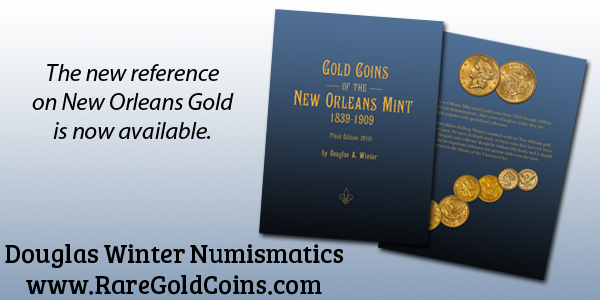
LOOSE CHANGE: JUNE 23, 2019
Here are some additional items in the media this week that may be of interest. -Editor
Breen Daughter's Book Going to Print
 Moira Greyland, daughter of numismatic author and researcher Walter Breen and his science fiction author wife
Marion Zimmer Bradley, published her autobiography last year as a Kindle e-book. It's been an Amazon bestseller for weeks and is scheduled to be
published in print next month. Thanks to Rich Bottles Jr. for passing this along. -Editor
Moira Greyland, daughter of numismatic author and researcher Walter Breen and his science fiction author wife
Marion Zimmer Bradley, published her autobiography last year as a Kindle e-book. It's been an Amazon bestseller for weeks and is scheduled to be
published in print next month. Thanks to Rich Bottles Jr. for passing this along. -Editor
To read the complete article, see:
Daughter of
famed sci-fi author reveals sexual horrors she suffered growing up in LGBT home
(https://www.naturalnews.com/2019-06-14-daughter-of-famed-sci-fi-author-reveals-sexual-horrors-she-suffered-growing-up-in-lgbt-home.html)
To read the earlier E-Sylum article, see:
NEW BOOK: THE LAST CLOSET (https://www.coinbooks.org/v21/esylum_v21n01a04.html)
Bulgari Coin Watches
From The Telegraph, an article about the latest Bulgari coin jewelry. -Editor
 Exploring ways to bring
material interest to a watch dial is as old as timekeeping itself. And one of the most interesting ways to add face value has been using coins -
either as a dial or as the entire case. Rare versions of pocket and wristwatches from Patek Philippe, Vacheron Constantin and Audemars Piguet
featuring currencies from the US, Switzerland, France and Mexico have all raised their heads at auction.
Exploring ways to bring
material interest to a watch dial is as old as timekeeping itself. And one of the most interesting ways to add face value has been using coins -
either as a dial or as the entire case. Rare versions of pocket and wristwatches from Patek Philippe, Vacheron Constantin and Audemars Piguet
featuring currencies from the US, Switzerland, France and Mexico have all raised their heads at auction.
Piaget's acclaimed Dalí D'or watches and jewellery use the coins Salvador Dalí minted in the 1960s and 1970s incorporating like-nesses of himself and his wife Gala. Among the most prolific are the Corum Coin Watches using gold dollar coins and worn by US presidents including Richard Nixon, Jimmy Carter, Ronald Reagan and Bill Clinton. Even Andy Warhol had a Corum Coin Watch in his celebrated collection.
To read the complete article, see:
Bulgari celebrates ancient
coins as old as 337AD with its new Octo Romana Monete watch
(https://www.telegraph.co.uk/luxury/watches/bulgari-celebrates-ancient-coins-old-337ad-new-octo-romana-monete/)
Venezuela's Secret Gold Shipments
Martin Kaplan passed along this Wall Street Journal piece about secretive gold shipments from Venezuela. Thanks. -Editor
 The government of Venezuelan President Nicolás Maduro is selling off his country's gold reserves. Some of it has passed
through a secretive operation in East Africa, a gambit that evades U.S. sanctions.
The government of Venezuelan President Nicolás Maduro is selling off his country's gold reserves. Some of it has passed
through a secretive operation in East Africa, a gambit that evades U.S. sanctions.
On two early-March flights, at least 7.4 tons of gold with a market value over $300 million moved from Venezuela to a refinery in Uganda, say officials in Venezuela and Uganda, a foreign diplomat and Venezuelan opposition lawmakers, who have concluded Mr. Maduro's government exported the ingots.
The gold arrived on a Russian charter jetliner in two shipments at the international airport in Entebbe, says Ugandan national-police spokesman Fred Enanga. The accompanying paperwork identified the ingots, some with stamped labels partially scratched off, as Venezuelan central-bank property, says a senior Ugandan police officer who saw the bars and documents. Flight records show the trips originated in Caracas, Venezuela.
The shipments expose one link in a global underground economy many suspect is helping Mr. Maduro cling to power by bypassing the U.S.-dominated international finance system.
To read the complete article (subscription required), see:
How 7.4 Tons of Venezuela's Gold
Landed in Africa—and Vanished (https://www.wsj.com/articles/how-7-4-tons-of-venezuelas-gold-landed-in-africaand-vanished-11560867792)
The Maven Game
Many of our book fans are also writers, so I thought I'd share a link to a great blog on writing called The Maven Game by David Moldawer. This particular post is an excellent piece of writing itself, with some interesting observations about movie sequels, in particular "long hiatus sequels" - think of Paul Newman in The Color of Money, made 25 years after The Hustler. It draws on references as diverse as Ben Franklin's Leather Apron club, cicadas and Seinfeld (check out the link to a classic episode). -Editor
By the time Harrison Ford and Mark Hamill are long gone, we'll be enjoying long-hiatus sequels featuring septuagenarian Daisy Ridley using the Force to fetch her slippers.
To read the complete article, see:
perpetual stew (https://mavengame.com/2019/06/perpetual-stew/)
Movable Type: A Chinese Invention
And for bibliophies, here's an interesting article on the invention of movable type - and it wasn't you-know-who. -Editor
The printing press is often said to have been created by Gutenberg in Mainz, Germany, around 1440 AD, and it began taking root in Europe in the 1450s with the printing of the aforementioned Bible. Books themselves had been present in Europe long before then, of course, but only in hand-copied volumes that were accessible mainly to members of the clergy. Access to mass-produced books revolutionized Europe in the late 1400s, with advancing literacy altering religion, politics, and lifestyles worldwide.
At least, this is how the story is rendered in most books, including, for the most part, The Lost Gutenberg. But a single sentence late in the book nods to a much longer story before that: “Movable type was an 11th-century Chinese invention, refined in Korea in 1230, before meeting conditions in Europe that would allow it to flourish—in Europe, in Gutenberg's time.”
To read the complete article, see:
So, Gutenberg Didn't Actually Invent the Printing Press
(https://lithub.com/so-gutenberg-didnt-actually-invent-the-printing-press/)
PENNY PYRAMID HOPES TO BREAK GUINNESS RECORD
I've been a while since we've had a story on coin art. Here's an Arizona man who built a pyramid of over one million cents in hopes of snagging a Guinness world record. From the New York Post. -Editor
 An Arizona man can finally put his penny-pinching days behind him.
An Arizona man can finally put his penny-pinching days behind him.
After three years of meticulous work, Cory Nielsen, 55 from Phoenix, has completed construction on what he hopes will be crowned the world's largest coin pyramid, after placing the final penny on June 16.
Now, 1,030,315 pennies and 46 YouTube videos later, Nielsen made the announcement via his aptly named channel, Penny Building Fool, posting a six-minute time-lapse of the building process.
“It measures 65 stacks across by 65 stacks back by 65 stacks high. Each stack contains 11 pennies,” he explains in the description of the video.
Even more impressive, there is no glue involved.
“I'm free stacking these — no glue, welding or anything other than simply balancing on top of each other.”
The hopeful world record holder, who spent a real-time total of 1.8 years on building the coin pyramid, now anxiously awaits his title after applying for the record with The Guinness Book of World Records.
After that, he plans to cash them in at the bank.
To read the complete article, see:
Arizona man builds pyramid out
of 1 million pennies in world record attempt
(https://nypost.com/2019/06/19/arizona-man-builds-pyramid-out-of-1-million-pennies-in-world-record-attempt/)

